 |
[ Outlaw Genealogy | Bruce
History | Lost Chords ] [ Projects | News | FAQ | Suggestions | Search | HotLinks | Resources | Ufo ] |
 |
[ Outlaw Genealogy | Bruce
History | Lost Chords ] [ Projects | News | FAQ | Suggestions | Search | HotLinks | Resources | Ufo ] |
Utlage / Outlagh /Outelawe / Outlawe 's in Bristol - Ralph Utlage and his son John Utlage - 1186-1210
Timeline:
1051 - In October Godwin and the rest of his sons were declared outlaws and given five days to leave the country. The men of Dover were left unpunished. Godwin, his wife Gytha, and his sons Swein, Tosti and Gyrth boarded ship at Bosham and left for Flanders. Harold and Leofwine Godwinson sailed from Bristol for the Norse stronghold of Dublin in Ireland.
1129 - Robert Fitzroy, Earl of Gloucester - illegitimate son of Henry I, grandson of William the Conqueror, founded the Priory of St James Bristol in 1129
First Record of Utlage ----- >
1150~1169 - Bromholm
Priory - House of
Glanville - Charter
of Bartholomew de Glanville To Bromholme Priory - Walteri
Utlage - And two thirds of the tithes of MY MEN: that is, my
uncle by my mother, Roger de Bertuna: And Geoffrey, priest of
Honinges: and Turstan despensatoris: Warini de Torp, Ricardi Hurel,
Walteri Utlage: and Roberti de Buskevill: And the tenth of the whole Ricardi
filii Ketel. - It is interesting that there are no Outlawe
records between 1170 and 1194 ...
1166 - Dairmait
Mac Murchada the King of Leinster sailed to Britain and met with King Henry II
of England... Mac Murchada then travelled to Bristol, where he
recruited the Earl of Pembroke, Richard FitzGilbert de Clare (better known
as Strongbow) as well as a handful of lesser Anglo-French barons
including Robert FitzStephen, Richard FitzGodebert, Maurice FitzGerald,
Raymond le Gros and Milo de Cogan. (See a note on
Norman names.)
1166 - August,
1166, Robert Fitz-Harding of Bristol entertained Dermot MacMurrough,
King of Leinster, his daughter, Eva, and sixty of his followers at a feast
in Bristol
1169 - Norman
Invasion of Ireland Begins - (Earl
of Pembroke Richard DeClare) Strongbow
who led the initial invasion of Ireland - 1 May 1169 Main
body of Norman, Welsh
and Flemish
forces landed in Wexford ,
near Bannow, County
Wexford. This was at the request of Dermot
MacMurrough (Diarmait Mac Murchada), the ousted King
of Leinster who sought their help in regaining his kingdom.and with the
approval of Henry II, - Topic
1171 - The people of Bristol were given Dublin as a colony by the king and many Bristolians settled there. Charter was issued by Henry II in 1171-1172, giving the men of Bristol the right to live in the City of Dublin. Later charters contain grants to the city of rights, privileges and property
1170-1183 -William, earl of Glocester died AD 1183 ... One of his Deeds,
which conveys land in Lewins-mead and
Broad-mead, ...:
1170-1183 - No.
174. Grant by Adam de Hel', clerk of the Earl of Gloucester, to Robert,
son of Swein, of various lands and houses held by Blakcman, Lewinus
Lari, and Hugo Margan, from the market of Bristol, and a long house and land
next to the house of William Traine in the market, etc.
There are no exact dates to these contracts
but the first had to be when Alan was abbot of Tewkesbury 1186-1202:
Cartae et alia munimenta quae ad dominium de Glamorgancia pertinent - page 256
Before 1186 - John, son of Ralph Outlawe. Leowini the whole of that land in the meadow. Ralph his father had bought from the Ailwardo weaver.
Second
Record of Utlage ----- >
1186~1202 - Confirmation
by the Prior of St. James's, Bristol, to John, son of Ralph
Utlage, of land in Lewin's Mead
1200~1210 - Grant
by the Prior of St. James's, Bristol, to Margam Abbey, of land in Lewin's
Mead, Bristol, Formerly held by John, son of Ralph le Utlage
1210~ - Margam Abbey - John, son of Ralph Utlage, of the land in the meadow of Leowine, known as Lewin's-mead, near to St. James' Church, Bristol. - dated in the early years of the thirteenth century.
1313 - Willielmus Outlagh - The Tallage of 6 Edward II - Bristollia Bristol - Tallage - Bristollia or, memoirs of the city ... - Gloucestershire - Bristol
1390 - ... in favour of Richard Bedewynde of Redynge 'hosteler' and John Hosteler 'that was Richardes servant Bedewynde' of Redynge at suit of John Outlawe of Bristol
1392 - Simon Outelawe, Michael Brailes plaintiffs - 18 shops in Bristol and suburbs
1420 - Lease for life of 2 - Johanna Outlawe widow of John Outlawe sen. peautner (sic) Premises: parcel of land in churchyard 30ft long and 14ft broad which John Outlawe held - 8 Hy.V (1420) 12 May - Bristol Record Office - St James Parish, Bristol
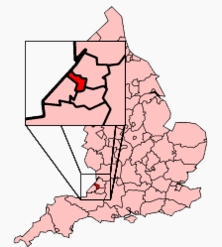 So at the same time
period, we have a Robert Utlage at Hindringham and his son Alan
Utlage (plus Alan's wife Emma), here we have John Utlage, and his son
Ralph Utlage at Bristol !
So at the same time
period, we have a Robert Utlage at Hindringham and his son Alan
Utlage (plus Alan's wife Emma), here we have John Utlage, and his son
Ralph Utlage at Bristol !
It
is interesting that
Lewin is a another name for Leofwine and that later the Outlaw's
donates "Lewin's Mead " in Bristol to Margam Abbey. It was from
Bristol in 1051 that Leofwine and Harold Godwinson left for Dublin Ireland
during their Banishment.
What is also significant is that often lands were "donated" when men
went on crusade in return to taking care of their affairs at home.
We now know that Lewin's meadow was probably called that because of the early owner : Lewinus Lari
St James Priory - IS THE OLDEST BUILDING IN BRISTOL.(1129)
St
John's Bridge Sugar House, and Lewins Mead area of Bristol, 1799.
Line drawing of 1799 plan of Lewins Mead & St John's Bridge area of Bristol
[BRO 36772 Box 12] 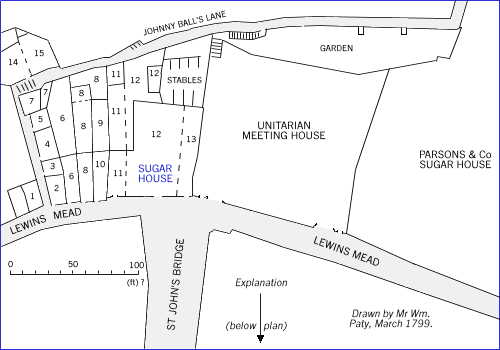
1170-1183 -William, earl of Glocester died AD 1183 ... One of his Deeds,
which conveys land in Lewins-mead and
Broad-mead, ...:
1170-1183 - No.
174. Grant by Adam de Hel', clerk of the Earl of Gloucester, to Robert,
son of Swein, of various lands and houses held by Blakcman, Lewinus
Lari, and Hugo Margan, from the market of Bristol, and a long house and land
next to the house of William Traine in the market, etc.
Full
text of Journal of the British Archaeological Association
...
No. 174. Grant by Adam de Hel', clerk of the Earl of Gloucester, to
Robert, son of Swein, of various lands and houses held by
Blakeman, Lewinus Lari, and Hugo Margan, from the market of Bristol, and
a long house and land next to the house of William Traine in the market,
etc.
So Lewin's Mead is named after the original holder Lewinus Lari and the Land was initially given to Robert fitz Swein from Earl of Gloucester who died 1183 , So sometime between 1183 and 1200 some of this land comes to Robert Utlage...
Robert
Fitz Suein married GUNNOR
BIGOD
Son : HENRY2
FITZ SUEIN, b. in Essex,
England, United Kingdom;
Daughter: AGNES3
FITZ SUEIN (Henry2,
Robert1),
daughter of (2) Henry2
and Cicely (_____) FITZ SUEIN, was
born between 1109 and 1149, and died between 1164 and 1259. She married in
1162/3, (AQB-4) AUBREY
DE VERE, 1ST
EARL OF OXFORD,
son of (AQB-2) Aubrey
II and (O-7) Alice
(de CLARE), who died on 26 Dec. 1194
Child: See (AQB-4) Aubrey
de VERE, 1st Earl of Oxford
| - - - - -
1051 - In October Godwin and the rest of his sons were declared outlaws and given five days to leave the country. The men of Dover were left unpunished. Godwin, his wife Gytha, and his sons Swein, Tosti and Gyrth boarded ship at Bosham and left for Flanders. Harold and Leofwine Godwinson sailed from Bristol for the Norse stronghold of Dublin in Ireland.
Margam Abbey - was a Cistercian monastery, located in the village of Margam, a suburb of modern Port Talbot in Wales.
The abbey was founded in 1147 as a daughter house of Clairvaux by Robert, Earl of Gloucester and was dedicated to the Blessed Virgin Mary
A history of Margam Abbey - Possessions of the Abbey in the towns of Bristol and Cardiff
IN addition to the early gifts of house property in Bristol which were, as we have already observed, granted by several owners, and confirmed by Pope and King, to the Abbey, it will be convenient in this place to group together a small collection of charters which relate to that town, and must be dated in the early years of the thirteenth century.
A confirmation (T. 290 .16; C. DCCLXXI ) by W , prior of St. James, Bristol, by assent of Alan, Abbot of Tewkesbury ( A.D. 1186-1293,), to John, son of Ralph Utlage, of the land in the meadow of Leowine, which the said Ralph purchased of Ailward Textor, or the Weaver; at the yearly rent of twelve pence, and the heriot of one pound of pepper.
The land is now known as Lewin's-mead, near to St. James' Church, Bristol. To this deed belongs the confirmation (T. 290. 15 ; C. DCCLX), by the same prior, to Margam Abbey, of the above land, which John, son of Ralph de Utlage, held of the Priory, and which the Priory held of the gift of Henry Cumin.
Rent as before stated. In the Abbey Rolls is the record of an undertaking closely connected with the above (T. 290.32 ; C. MLXV), by William de Bellomonte, to pay six shillings yearly to the Abbey for tenements which he holds in fee-farm in the town of Bristol, viz. : four shillings in the meadow of Lewin, which the Abbey has of the gift of John Utlage ; and two shillings for land between St. Peter's Church and the Castle ; and to pay twelve pence yearly to the Prior of St. James, and sixpence to Walter Cumin, for the said land in the meadow of Leuuin. He is not to give, sell, or exchange the land without consent of the abbot.
Margam Abbey charters - City and County of Swansea
1147 - Margam Abbey founded when Robert of Gloucester, Lord of Glamorgan granted land at Margam to St.Bernard's Abbey, Clairevaux, Normandy for the founding of a Cistercian Monastery - Same year as the Second Crusade begins
1147 - Margam Abbey was founded in 1147 by Robert Consul (died 1147), Earl of Gloucester, as a Cistercian house. The foundation gift consisted of lands between the rivers Afan and Kenfig. The abbey later received the manor of Resolven, and many other lands, making it the richest religious house in Wales. - Grant By William De Bonville to Margam Abbey of land held by the Templars in the time of his father - Robert Consul = Robert Fitz Roy - illegitimate son ot Henry I and Nesta (Wales) - William Fitz Robert - Son of Robert Consul - Nest ferch Rhys - (died after 1136) was a Welsh princess of Deheubarth who was renowned for her beauty - After her father's death in 1093, Deheubarth was conquered by the Normans and King Henry I of England appointed himself her protector. Nest is thought to have borne him a son, Henry FitzRoy (1103-1158). -Around 1095 King Henry decided to marry Nest to one of his followers, Gerald de Windsor, whom he appointed Constable of Pembroke. Consequently, Nest is the maternal progenitor of the FitzGerald dynasty - Robert, 1st Earl of Gloucester
St James'
Priory, Bristol - It was founded in 1129 as a Benedictine
priory by Robert,
Earl
of Gloucester, the illegitimate son of Henry
I.
The nave survives from 1129 but the tower was added around 1374
1147-49 - Second
Crusade
1147 - On
May 19, 1147, the first contingents of crusaders left from Dartmouth
in England, consisting of Flemish,
Frisian,
Norman, English,
and Scottish
crusaders, and some from Cologne,[4]
who collectively considered themselves "Franks".[5]
No prince or king led this part of the crusade, England at the time being in the
midst of The
Anarchy. The fleet was commanded by "Hervey"
Henry
Glanville, Constable of Suffolk.[6][7]
Other crusader captains included Arnold
III of Aerschot, Christian of Ghistelles, "the
men of Kent under" Simon of Dover, Andrew of London, and
Saher of Archelle.[8]
- Fall of Lisbon
- The siege began on July 1. The Christians soon captured the
surrounding territories and besieged the walls of Lisbon itself. After four
months, the Moorish
rulers agreed to surrender (October 21), because the Crusaders' siege
tower reached their wall (thus causing a one day standstill) and because of
hunger within the city, which was sheltering populations displaced from Santarém
as well as "the leading citizens of Sintra,
Almada, and Palmela."[11]
- Some of the crusaders set sail and continued to the Holy Land.[6]
Most of the crusaders however settled in the newly captured city, and Gilbert
of Hastings was elected bishop
- Frank
Leslie's popular monthly
1210~ - Margam
Abbey - John, son of Ralph Utlage, of
the land in the meadow of Leowine, known as Lewin's-mead, near to St.
James' Church, Bristol. - dated in the early years of the
thirteenth century.
1313 - Willielmus
Outlagh - The Tallage of 6 Edward II - Bristollia Bristol
- Tallage - Bristollia
or, memoirs of the city ...
(Possibly William Outlaw from Ireland? )
1392 - Simon
Outelawe, Michael Brailes plaintiffs - 1392 Sept. 29.-Oct. 5] York - Premises:
9 messuages, 18 shops in Bristol and suburbs
1420 - Lease
for life of 2 - Johanna Outlawe widow of John Outlawe sen. peautner (sic)
Premises: parcel of land in churchyard 30ft long and 14ft broad which John
Outlawe held - 8 Hy.V (1420) 12 May - Bristol Record Office
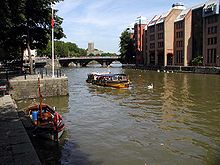 Bristol
- The town of Brycgstow (Old
English, "the place at the bridge")[15]
appears to have been founded in c.1000... The area around the original
junction of the River
Frome with the River
Avon, adjacent to the original Bristol
Bridge and just outside the town walls, was where the port began to
develop in the 11th century. By the 12th century Bristol was an important port,
handling much of England's trade with Ireland. In 1247 a new stone bridge was
built...
Bristol
- The town of Brycgstow (Old
English, "the place at the bridge")[15]
appears to have been founded in c.1000... The area around the original
junction of the River
Frome with the River
Avon, adjacent to the original Bristol
Bridge and just outside the town walls, was where the port began to
develop in the 11th century. By the 12th century Bristol was an important port,
handling much of England's trade with Ireland. In 1247 a new stone bridge was
built...
Golden Gallery - Swansea Parklands - Margam Park 2007
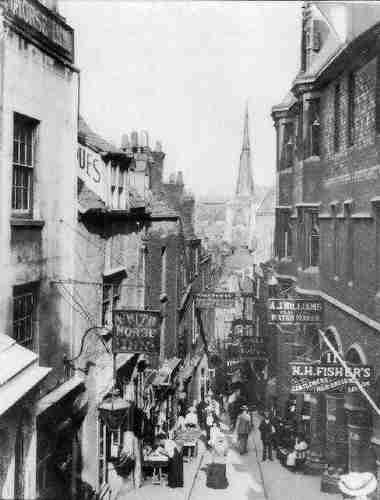 1899
Lewins Mead Bristol BS1 - A crowded Christmas Steps in the
Victorian era with straw boaters mixing with flat caps.
1899
Lewins Mead Bristol BS1 - A crowded Christmas Steps in the
Victorian era with straw boaters mixing with flat caps.
This is one part of ancient Bristol that has survived, virtually unchanged
apart from the signs but the city beyond is very different.
At one time sailing ships moored at the bottom of these steps before the river
Frome was covered over.
Lewin's Mead - is an area of Bristol, England, part of the city ward of Cabot, in the historic centre of the city, lying just outside of the former medieval town walls.... It is not known who the original Lewin was. The area was situated outside the medieval city walls and was partly occupied by the estate of St Bartholomew's Hospital and also by Greyfriars, Bristol.
St Bartholomew's Hospital, Bristol - is at the bottom of Christmas Steps, in Lewin's Mead, Bristol, England. ... This 12th century town house was incorporated into a monastery hospital founded in 1240 by Sir John la Warr, 2nd Baron De La Warr (c. 1277–1347) ( Notice the future owner of Delaware)
Greyfriars, Bristol - It was founded at some time before 1234, within the town walls and then moved to Lewin's Mead in 1250. The site included extensive gardens surrounded by a stone wall....Archaeological investigations have found graves with human remains, dating to the thirteenth to fifteenth century,[16] and a medieval conduit,[14] similar to one excavated at Saint Augustine's Abbey in Bristol
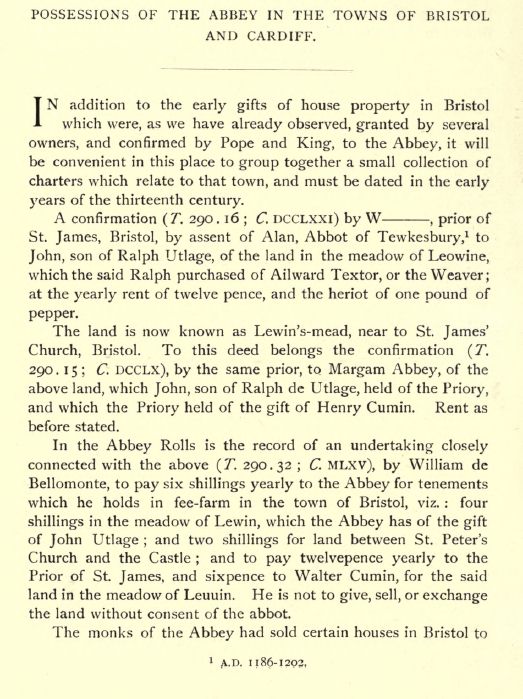 CHAPTER XVII. POSSESSIONS OF THE ABBEY IN THE TOWNS OF BRISTOL AND
CARDIFF.
CHAPTER XVII. POSSESSIONS OF THE ABBEY IN THE TOWNS OF BRISTOL AND
CARDIFF.
IN addition to the early gifts of house property in Bristol which were, as we have already observed, granted by several owners, and confirmed by Pope and King, to the Abbey, it will be convenient in this place to group together a small collection of charters which relate to that town, and must be dated in the early years of the thirteenth century.
A confirmation (T. 290 .16; C. DCCLXXi) by W , prior of St. James, Bristol, by assent of Alan, Abbot of Tewkesbury, 1 to John, son of Ralph Utlage, of the land in the meadow of Leowine, which the said Ralph purchased of Ailward Textor, or the Weaver; at the yearly rent of twelve pence, and the heriot of one pound of pepper.
The land is now known as Lewin's-mead, near to St. James' Church, Bristol. To this deed belongs the confirmation (T. 290. 15 ; C. DCCLX), by the same prior, to Margam Abbey, of the above land, which John, son of Ralph de Utlage, held of the Priory, and which the Priory held of the gift of Henry Cumin. Rent as before stated. In the Abbey Rolls is the record of an undertaking closely connected with the above (T. 290.32 ; C. MLXV), by William de Bellomonte, to pay six shillings yearly to the Abbey for tenements which he holds in fee-farm in the town of Bristol, viz. : four shillings in the meadow of Lewin, which the Abbey has of the gift of John Utlage ; and two shillings for land between St. Peter's Church and the Castle ; and to pay twelve pence yearly to the Prior of St. James, and sixpence to Walter Cumin, for the said land in the meadow of Leuuin. He is not to give, sell, or exchange the land without consent of the abbot. 1 A.D. 1186-1293,
Noticed that not all the document links to the Margam Abbey - Bristol were linked:
Notice that although the records were found with Margam's Abbey , the original agreement was with Saint James Priory that then in turn donated the land to Margam Abbey. These were the original recording of "deeds" with the church acting as the recorder.
. This seems to be the original link to Earl of Gloucester and the invasion of Ireland:
A history of Margam Abbey - Possessions of the Abbey in the towns of Bristol and Cardiff
1210~ - Margam Abbey - John, son of Ralph Utlage, of the land in the meadow of Leowine, known as Lewin's-mead, near to St. James' Church, Bristol. - dated in the early years of the thirteenth century.
| - - - -
1186~1202 - Confirmation
by the Prior of St. James's, Bristol, to John, son of Ralph
Utlage, of land in Lewin's Mead
1200~1210 - Grant
by the Prior of St. James's, Bristol, to Margam Abbey, of land in Lewin's
Mead, Bristol, Formerly held by John, son of Ralph le Utlage
1186~1202:
Cartae et alia munimenta quae ad dominium de Glamorgancia pertinent
Page 256:
CCLVI.
CONFIRMATION BY THE PRIOR OF ST. JAME'S, BRISTOL, TO JOHN, SON
OF RALPH UTLAGE, OF LAND IN LEWIN'S MEAD.
[Margam Charter.]
Sciant p. et f. quod ego W. prior ecclesie Santi Jacobi de Brist[ollia] et
fratres ejusdem loci . auetoritate et concessu venerabilis patris nostri Alani
abbatis Theokesbirie et ejusdem loci eonventus . concessimus . et hac carta
confiimavimus . Johanni filio Radulphi Utlage . totam terram illam in prato
Leowini . quam Radulphus pater suus emit de Ailwardo textore. Tenendam
et habendam predictam terram de ecelesia beati Jacobi sibi et heredibus suis .
libere et quiete hereditabiliter . reddendo inde annuatim ecclesie Sancti Jacobi .
XII. denarios ad festum Sancti Michaelis . pro omni servitio et exactione. Et in
mutatione heredum heredes sui dabunt ecclesie Sancti Jacobi . dimidiam libram
piperis de recognitione. Quod ut ratum et stabile permaneat . presentem cartam
sigilli nostri appositione roboravimus. Hiis testibus.
Entitled—' Carta ejusdem de eodem.'
' Pratum Leowini ' is Lewin's Mead, near to St. Jame's Church in Briatol.
The pound of pepper payable on change of heir is a very early example of
heriot.
| - - - -
They must know that p. and f. I W. prior of St. James of Bristol, and the brethren of that place authority and the retirement of our venerable father, Alan Theokesbirie [ Tewkesbury ] abbot and convent of that place granted and confirmed this Charter. John, son of Ralph Outlawe. Leowini the whole of that land in the meadow. Ralph his father had bought from the Ailwardo weaver. Hold and to have the said land of the church of the blessed James to himself and to his heirs. freely and heritably. an annual payment of the church of St James. 12. pence on the feast of St. Michael. for all service and exaction. And in a change of the heirs of his heirs, they shall give to the church of St James half a pound of pepper on the acknowledgment. As approved remain firm and stable. by the strength of the present charter of the placing of our seal.. These being witnesses.
The charter of the same.
CCLVII.
GRANT BY THE PRIOR OF ST. JAMES'S, BRISTOL, TO MARGAM ABBEY, OF LAND IN LEWIN'S
MEAD, BRISTOL, FORMERLY
HELD BY JOHN, SON OF RALPH LE UTLAGE.
[Margam Charter.]
Sciant presentes et futuri . quod ego . W. dictus prior Sancti Jacobi de
Brist[ollia] et monachi ibidem Deo servientes . concessimus et hac presenti carta
nostra confirmavimus ecclesie beate Marie de Margan . et conventui ejusdem
loci . quaudam terram in prato Leowini . illam scilicet quam Johannes filius
Radulphi le Utlage de nobis tenuit . quam etiam de dono Henrici Cumin
habuimus. Tenendam et habendam predictam terram prediote ecclesie et ejusdem
loci conventui . de nobis et successoribus nostris in perpetuum . reddendo inde
annuatim . uobis et sucoessoribus nostris xii. denarios ad festum Sancti Michaelis
pro omni servitio. Quod ut magis ratum sit et inconoussum . presens scriptum
sigilli nostri appositione dignum duximus confirmandum.
Entitled— ' Cyrographum Prioris Sancti Jacobi de terra Utlage.'
Know all present and future. what I want. W. the said prior of Saint James in Bristol and the monks serving God there granted, and by this our present charter confirmed to the church of blessed Mary of Margan and the convent of that place. quaudam Leowini land in the meadow. namely, that which John the son of Ralph Outlawe of held of us. Also we have had of the gift of Henry Cumin to Hold and to have the aforesaid land to the aforesaid church and of the same place for the meeting of us and our successors for ever. an annual payment. us and our successors of the Twelve. pence at the feast of the Holy Michael for all service. In order to be valid and unchanged for more. the present writing shall have thought fit to encourage the placing of our seal.
Chirograph Prior of St. James of Outlawe
| = = = = =
Heriot
Latin, herietum.
Heriot means 'war gear', a death
duty paid
by the higher nobility in Anglo-Saxon England. It took the form of the
'return' of the weapons and horses with which a lord was presumed to have
endowed his man when the bond between them was forged. Heriots were paid right
up to the Conquest, a strong indication of the continuing military ethos of the
Anglo-Saxon nobility down to 1066. In the late Anglo-Saxon period, a tariff was
enshrined in the laws of King Canute. According to this code, for example, the
heriot of an earl was eight horses - four saddled and four unsaddled - four mail
coats, four helmets, eight spears, eight shields, four swords, and a substantial
payment in gold. In other words, the war gear for four fully-equipped warriors
and their attendants. Heriots could be commuted to cash payments, and often were
for the lesser nobility; Domesday Book records several examples.
As a death duty, heriots could be confused with reliefs,
which strictly speaking were inheritance taxes rather than a death duties. After
the Conquest, death duties and inheritance taxes became fused, and relief
superseded heriots as far as the nobility was concerned.
Relief
Latin, relevatio.
The relief was a payment offered by an heir to an overlord for the right to
succeed to an estate. As such, it could be confused with the heriot,
a death
duty rather
than an inheritance tax. Domesday Book does confuse the two on occasions, as did
other contemporary sources. In part, this is due to an inherent ambiguity
between a death duty and an inheritance tax, both being succession payments in
fact if not in name or origin.
After the Conquest, in fact, the two were fused. Thereafter, succession dues
paid by peasantry were generally known as heriots, those by the aristocracy as
reliefs. Reliefs also appear to have become more onerous after the Conquest.
As early as the reigns of the Conqueror's two sons, they were politically
charged issues, so much so that on his coronation Henry I felt obliged to
renounce the arbitrary sums levied by his brother and content himself with 'just
and lawful reliefs'. They remained, however, a major source of grievance down to
Magna Carta.
St James Priory - ST JAMES PRIORY IS THE OLDEST BUILDING IN BRISTOL.
Explore the fascinating history and heritage of St James Priory – the oldest building in Bristol still in use today.
Robert Fitzroy, Earl of Gloucester and illegitimate grandson of William the Conqueror, founded the Priory of St James in
1129. It has been used as a place of worship for 900 years.
In the medieval period, St James Priory was home to Benedictine monks. They lived here as a community of brothers, devoting their lives to worshipping God and caring for the poor and the sick. The Priory was dissolved during the reign of Henry VIII, and many of its buildings were demolished. Only the west end survived as a smaller parish church, and is still used for worship today.
Now, St James Priory provides residential support and treatment for people suffering from substance addiction and/or homelessness
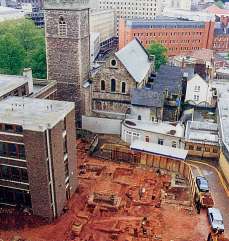 Excavations
at St James Priory
Excavations
at St James Priory
Bristol’s oldest building is now home to Bristol’s newest cafe. The twelfth-century St James’ Priory, tucked away behind the bus station, recently reopened after a £3.5 million renovation and repair
project. Last week, Cafe Refectoire opened its doors for the first time, a lovely little cafe and a much-needed new revenue scheme for the continued maintenance of St James’.
Situated in the east entrance of the priory – in medieval times home to Benedictine monks, now an addiction centre – Cafe Refectoire is situated in a new addition next to the 1129 building. Inside, there are a couple of tables next to a glass screen through which you can see the church where mass is still celebrated every Sunday.
Line drawing of 1799 plan of Lewins Mead & St John's Bridge area of Bristol [BRO 36772 Box 12]
| - - - - - - -
Lewin's Mead - The Changing Face of Bristol
Lewin's Mead BS1 - a set on Flickr
| - - - -
Memoirs historical and topographical of Bristol and it's neighbourhood - Vol I
Before John's marriage with Isabella could be solemnized, the earl of Gloucester died. "Earl William dyed (f) in Brightestow" "castel, and willed to be buried with his father at St James; but he was Privately conveyed by night unto Cainsham, to which he had given the whole lordship of Marschefel, and impropriated the benefice thereof unto St James's Priory; and the benefice consequently came to Theokesbyri [ Tewkesbury !!! ] . [ There was as it is said, a nunnery at Marschefeide ]
The anonymous historian of that Abbey in Dugdale (g) places his death under the year mclcxiij, and so does the authour quoted by Leland (h): these two however are really but one authority, and it is manifestly an error (one x being omitted) because his transactions in 1175 and 1176 have been just mentioned. The Annals of Waverley are as follows. "William, earl of Glocester died AD 1183, on the same night on which he was born, that is on the night of St Clement[Nov' 23] which is no doubt correct. His large seal is 2£ inches in diameter, having a Tiger («) passant before a tall upright plant.
One of his Deeds, which conveys land in Lewins-mead and Broad-mead, has something observable. It is as follows, copied from two coeval patterns: the brackets contain the differences of one from the other.
[omnibus amicis et fidelibus hominibus suis de Bruist' salutem]- Notum sit vobis, me dedisse et concessisse Roberto fil' Suein et Christians uxori ejus et eorum heredibus, tcrram et domum quas Blachemannus [Blakemannus] tenet de me in feria [feira] dc Brist', et terrain et domum, quas Lefwinus [Lewinus] (A:) Lari tenet de me in feria [feira] de Bruist' [Brist']; et tcrram & domum quas Hugo Margam [Morgon] tenet de me in feria [feira] dc Bruist' [Brist']; et illam longam domum & terram, quae est juxta domum Will' Traine in feria de Brist' [in feira de Bruist']; et servicium Willelmi de Hereford [Herefort] de terra quam de me tenet in saepe dicta feria [feira], scilicet unam libram cumini per annum. Testibus Magistro Moise, nepote meo; Waltero Clerico; Willelmo capellano; Roberto fil' Osb'; Elia de Hintana [Hinetuna]; Roberto de Paris; Roberto de Penedoc; Waltero Hachat [Hacat]; Petro Camerario."
[Bruist of his men and to the faithful to all his friends 'salvation] - Be it known to you, that I have given and granted to Robert son of Suein and Christine his wife and their heirs, and the house of which the land Blachemannus [Blakemannus] he holds of me in the day of the week [feira] dc bright ', and land and house, which Lefwinus [Lewin] (A :) hold of me as the months go on a weekday [feira] of Bruist' [bright '], and house and land which Hugh mass in b minor [Morgon] holds of me in the day [feira] dc Bruist '[bright'], and of a long house and land, which is near the house of Will 'Train the day of the bright' [in the feira of Bruist ']; and service of William of Hereford [Herefort] from the land of which I have been said to hold in the day [feira], namely, one pound of cumin a year. Witnesses, Master Moses, my nephew, Walter Clerke, William, chaplain, son of Robert "OSB" Elijah of Hintana [Hinetuna] Robert of Paris, Robert Penedoc; Walter Hachat [Hacat] Peter Chamberlain. "
| - - -
Full text of Journal of the British Archaeological Association
...
No. 174. Grant by Adam de Hel', clerk of the Earl of Gloucester, to
Robert, son of Swein, of various lands and houses held by Blakcman,
Lewinus Lari, and Hugo Margan, from the market of Bristol, and a long house and land next
to the house of William Traine in the market, etc.
The text is much mutilated, but I am enabled to restore it from parallel passages in the next deed.
| - - -
ROBERT FITZ SUEIN has an unknown birthdate. He married GUNNOR BIGOD
HENRY2 FITZ SUEIN, b. in Essex, England, United Kingdom;
AGNES3
FITZ SUEIN (Henry2,
Robert1),
daughter of (2) Henry2
and Cicely (_____) FITZ SUEIN, was
born between 1109 and 1149, and died between 1164 and 1259. She married in
1162/3, (AQB-4) AUBREY
DE VERE, 1ST
EARL OF OXFORD,
son of (AQB-2) Aubrey
II and (O-7) Alice
(de CLARE), who died on 26 Dec. 1194[1].
Child: See (AQB-4) Aubrey
de VERE, 1st Earl of Oxford
Probably the person from whom Lewins-mead takes it's name. [ Lewinus Lari ]
Journal of the British Archaeological Association - British Archaeological Association
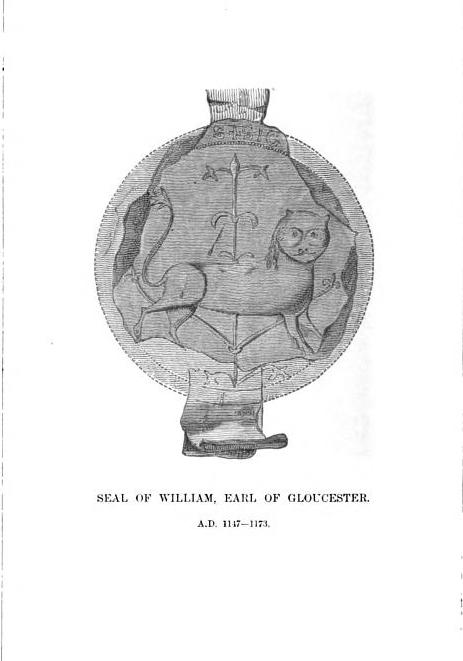 To this early charter, of the twelfth century, is appended a fine oval gem
seal, bearing a figure of Fortune holding a Victory and branch. The legend is
Sigillvm Adam De Hel'. - 1147 -
1173
To this early charter, of the twelfth century, is appended a fine oval gem
seal, bearing a figure of Fortune holding a Victory and branch. The legend is
Sigillvm Adam De Hel'. - 1147 -
1173
. Grant by Adam de Heli, clerk of the Earl of Gloucester, to Robert, son of Swein, of various lands and houses held by Blakeman, Lewinus Lari, and Hugo Margan, from the market of Bristol, and a long house and land next to the house of William Traine in the market, etc. The text is much mutilated, but I am enabled to restore it from parallel passages in the next deed.
No. 177. Grant by William, Earl of Gloucester, to the monks of St. James, Bristol, of the tenth penny of his mill at'Rumia. (See plate.)
Bristol, a historical and topographical account of the city - Alfred Harvey
...
Beginning at the south-west was the great Augustinian abbey, already described, and next, on the same knoll and only separated by College Green, came the Gaunts' Hospital, beyond which was the small house of Carmelites, the gardens of the two joining.
Beyond and lower down, but with its grounds stretching high up the hillside, was the important friary of Franciscans in Lewin's
Mead; and beyond this again, and standing a little higher up the hill, was the one foundation for Benedictine monks, the priory of St. James, built by the great Earl
Robert.
On the high ground above the two last there was a small convent of Benedictine nuns on St. Michael's Hill; and lastly, the semicircle was completed by the house of the Black or Dominican Friars, higher up the river, but occupying a low-lying situation beneath the shadow of the castle, at the east end of the town. Besides these there were hospitals which were to some extent religious foundations : the early St. Bartholomew's, near the Franciscan Friary, just outside the north gate, and the more recent, though still mediaeval, Foster's Almshouses on St. Michael's Hill, with a pretty Late Gothic chapel bearing the rare dedication to the Three Kings of Cologne; and lastly, beyond the ring and well removed from the populous town, there was a small hospital, perhaps two, for lepers, near the ford through the Frome, known as Lawford's Gate. On the south side of the Avon, too, there were some three or four religious houses, all small and unimportant, and now quite demolished.
The abbey of St. Augustine has already been described; of the others the earliest in date, and
perhaps the most important, was the Benedictine priory of St. James, founded by Robert, Earl of
Gloucester, early in the reign of Stephen, or in the closing years of that of Henry
I. It was never an independent house, but was a cell to the abbey of Tewkesbury, of which the earl was a great benefactor, as the son-in-law of its founder. It is said that
one tenth of the Caen stone imported for the building of the castle was devoted to the erection of the priory. Earl Robert endowed his foundation with the manor of Esselega, now Ashley, a northern suburb of Bristol, the tithes of various rents, all churches of his fee in Cornwall, and one church beyond the sea, that of Escrimoville, in Normandy. In addition he gave it the profits of a Whitsuntide fair held in the great open space in front of the priory, and the prior had also the prisage of all wines brought into the port of Bristol during the octave of St. James; the two last benefactions proved to be the source of much subsequent litigation.
The founder, who died October 31, 1147, was buried in the centre of the choir of the church, in a tomb of green jasper, which has entirely disappeared;
If Alan died in 1202 then we know that this first contract was at least before 1202: so when was he in town? St. Thomas Becket died in 1170 and Alan is removed to Tewkesbury in 1186 - So that gives a date between 1186 and 1202.
So when did Ralph Outlawe buy the land from Ailwardo the weaver ? I doubt we will ever know.
They must know that p. and f. I W. prior of St. James of Bristol, and the brethren of that place authority and the retirement of our venerable father, Alan Theokesbirie [ Tewkesbury ] abbot and convent of that place granted and confirmed this Charter. John, son of Ralph Outlawe. Leowini the whole of that land in the meadow. Ralph his father had bought from the Ailwardo weaver. Hold and to have the said land of the church of the blessed James to himself and to his heirs. freely and heritably. an annual payment of the church of St James. 12. pence on the feast of St. Michael. for all service and exaction. And in a change of the heirs of his heirs, they shall give to the church of St James half a pound of pepper on the acknowledgment. As approved remain firm and stable. by the strength of the present charter of the placing of our seal.. These being witnesses.
Alan of Tewkesbury - A Benedictine abbot and writer, d. 1202. Alan is stated by Gervase of Canterbury, a contemporary; chronicler, to have been English by race, i.e. not of Norman, or any immigrant, extraction. He is supposed to have spent some years at Benevento in Italy, before entering the Benedictine novitiate at Canterbury, where he became Prior in 1179. He zealously espoused the cause of the clergy against Henry II in the struggle which led to the martyrdom of St. Thomas; He was removed from Canterbury to the Abbey of; Tewkesbury, where he could less effectively oppose Henry's encroachments on the rights of the church; The intimacy with St. Thomas which Alan of Tewkesbury enjoyed, and his almost lifelong acquaintance with the politico-ecclesiastical controversies of the time, qualified him to write the "Life of St. Thomas", which (as Life of Becket) is printed in the second volume of "Materials for the History of Thomas Becket", edited by the Rev. J.C. Robertson (Rolls Series, London,; 1875-85; Part I, CXC, 1475-88). Alan also collected and arranged a number of the Saint's epistles. Critics are doubtful as to the genuineness of the other works traditionally ascribed to him.
Archbishop Baldwin, who succeeded Richard in 1184, was a Cistercian monk and a scholar, and did not look favourably upon the luxury, independence, and ignorance of the chapter. Urged probably by the clerks around him, he planned a large collegiate church, to be maintained out of the property of the see; and obtained from Lucius III permission to recover the estates alienated to the convent by his predecessor, of which the principal were the oblations, belonging canonically to the archbishop, and the churches of Monkton, Eastry, Meopham, and Eynsford; and began proceedings by confiscating the xenia on 15 December, 1185, and taking possession of the churches of Monkton and Eastry on 25 January, 1186. The monks, besides resenting this loss, considered that the cathedral would be supplanted by the new church, among the canons of which were to be the bishops of the province, and appealed to the new pope, Urban III. Baldwin, however, secured bulls from him, and in November came down to found his church at Hackington, a suburb of Canterbury, where he instituted the canons on 16 December. Alan, the prior, had been made abbot of Tewkesbury, but his successor Honorius was confirmed in fidelity to the convent by a vision which appeared opportunely to one of the monks, and went abroad to Verona to lay his case before the pope in person.
Priors Of Canterbury
Alan, (fn. 103) 1179-86
1186 - Alan, Prior of Canterbury, resigned and became Abbot of
Tewkesbury in 1186
Also we have had of the gift of Henry Cumin to Hold and to have the aforesaid land to the aforesaid church and of the same place for the meeting of us and our successors for ever. an annual payment. us and our successors of the Twelve. pence at the feast of the Holy Michael for all service.
So who was Henry Cumin ( Comyn ) ? Well, John Comyn was archbishop of Dublin from 1182 till his death in 1212 , which again is in the timeframe of this land transaction... (post Irish invasion 1169 )
Here again we
have the Anglo-Irish connection of men who left England for the invasion of
Ireland.
Notice the Somerset Bristol and Marisco connection:
So Henry Comyn was a relation of John Comyn?:
John Comyn (bishop) - (c. 1150 – 25 October 1212), born in England, was Archbishop of Dublin, Ireland
He was chaplain to King Henry II of England and on his "urgent" recommendation was elected Archbishop of Dublin following the death of St. Laurence O'Toole in 1180.[1] He had been a Benedictine monk at the Evesham Abbey.
In 1181, he was elected to the archbishopric of Dublin by some of the clergy of Dublin, who had assembled at Evesham for the purpose. He was not then a priest, but was subsequently, in the same year, ordained such, at Velletri, and on Palm Sunday (21 March) was there consecrated archbishop by Pope Lucius III. The following year the pope granted him manors and lands in and around Dublin, which subsequently formed the Manor of St. Sepulchre, which remained under the authority of the Archbishop of Dublin until the 19th century. The pope also, in an effort to protect the Dublin archbishopric from claims from Canterbury, extended certain privileges to Comyn, which intensified the rivalry between the sees of Dublin and Armagh for the Primacy of Ireland.[1]
Comyn waited three years before visiting Ireland, until he was sent there by King Henry to prepare the reception of his son, Prince John. The king granted him lands and privileges which made him a Lord of Parliament. After his arrival in Ireland John granted Comyn the Bishopric of Glendalough, with all its appurtenances in lands, manors, churches, tithes, fisheries and liberties, although Comyn never had an opportunity to take this up in his lifetime. Under Pope Urban III carried out a number of reforms of the Irish church to bring it into line with the church in England and in continental Europe.[1]
In 1189, Archbishop Comyn assisted at the coronation of King Richard I. The following year he demolished the old parish church of St. Patrick, south of Dublin, and erected a new building, next to his Palace of St. Sepulchre, which he elevated to the status of a collegiate church, and which later became St. Patrick's Cathedral. This enabled him to rule in his own Liberty, without the interference of mayor and citizens. About the same time he enlarged the choir of Christ Church Cathedral.[2]
Prince John granted Comyn further legal rights throughout the country of Ireland, while Comyn also received the church and lands of All Hallows, to the north-east of Dublin. Between Lusk and Swords he founded the convent of Grace Dieu, which later became wealthy through grants from the Anglo-Norman prelates and magnates. However, when Hamo de Valoniis (alias de Valois), was appointed Justiciar of Ireland he seized some of these lands for the treasury (with a good portion for himself), and a dispute arose which caused Comyn to flee for his own safety to Normandy. Comyn appealed to Pope Innocent III, who settled the dispute, but John was angered by the actions of Comyn, and did not reconcile himself with him until 1206.[1]
Comyn died six years later and was buried in Christ Church Cathedral, where a marble monument was erected to his memory.
Christ Church Cathedral, Dublin - Christ Church Cathedral (or, more formally, The Cathedral of the Holy Trinity) is the cathedral of the United Dioceses of Dublin and Glendalough and the cathedral of the Ecclesiastical province of the United Provinces of Dublin and Cashel in the Church of Ireland. [1] It is situated in Dublin, Ireland and is the elder of the capital city's two mediæval cathedrals, the other being St Patrick's Cathedral.
Norman period - Henry II attended the Christmas service at the cathedral in 1171. According to the cathedral guidebook this was the first time Henry received Holy Communion following the murder of Thomas Beckett by Henry's knights in Canterbury.
In the 1180s, Strongbow and other Norman magnates helped to fund a complete rebuilding of Christ Church, initially a wooden building, in stone, comprising the construction of a choir, choir aisles and transepts, the crypt and chapels to St. Edmund and St. Mary and St. Lô.
The Great Red Book of Bristol - Bristol (England)
1197 - Henry Cumin - Bristol
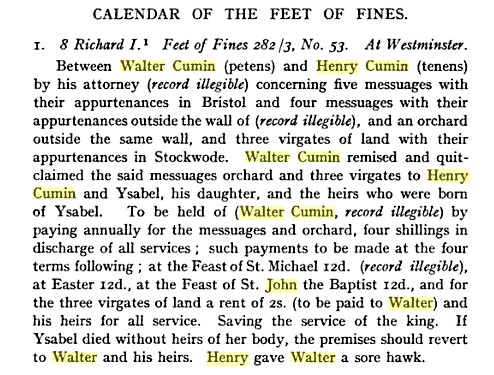
Snitterfield - is a village and civil parish in the Stratford on Avon district of Warwickshire, England,
Snitterfield was spelt as Snitfield. At the time of the Norman conquest of England Snitefeld was held by Saxi who also possessed land at Walton, Charlecote, Bramcote, Dorsington and Werlavescote but by 1086 it was held by the Count of Meulan; "in Ferncombe Hundred, Snitefeld.
Henry gave Walter a sore hawk.
Antiquarian Communications - Cambridge Antiquarian Society (Cambridge, England)
The number of similar instances might I have no doubt be much increased. I fear however it may rather be considered that I have given too many than too few, although I trust the matter may not be deemed altogether devoid of interest. A sore hawk was esteemed a gift worthy of a king, and it will be seen that one Sovereign did not deem it beneath his dignity to render it to another. Such a gift was no doubt rather honorary than valuable. May it not be fairly inferred that Robert de Brigham and his wife had no other recompense from the Countess of Pembroke for conveying to her the messuage which became the site or part of the site of the College of which she was the foundress, and that they are therefore entitled to honourable remembrance as having aided in carrying out her munificent and pious undertaking?
Hawk - The “Sore-hawk” is a hawk of the first year, so called from the French, sor or saure, brownish-yellow.
Sort of related "Strongbow's Dad Richard Fitz Gilbert de Clare, origin and the relationship to the Crusades and Mary Magdalene and the Cathars ( the crusade against the Cathars begins around 1200 but before then all these Mary Magdelene priories and Hospitals are put up by returning Norman crusaders ) Also the Outlawe's seems to be associated with "Pembroke"
Richard de Clare, 2nd Earl of Pembroke - Lord of Leinster, Justiciar of Ireland (1130 – 20 April 1176). Like his father, he was also commonly known as Strongbow (French: Arc-Fort). He was a Cambro-Norman lord notable for his leading role in the Norman invasion of Ireland. ... Richard was the son of Gilbert de Clare, 1st Earl of Pembroke and Isabel de Beaumont. Richard's father died when he was about eighteen years old and Richard inherited the title Earl of Pembroke. It is probable that this title was not recognized at Henry II's coronation
| - - - - -
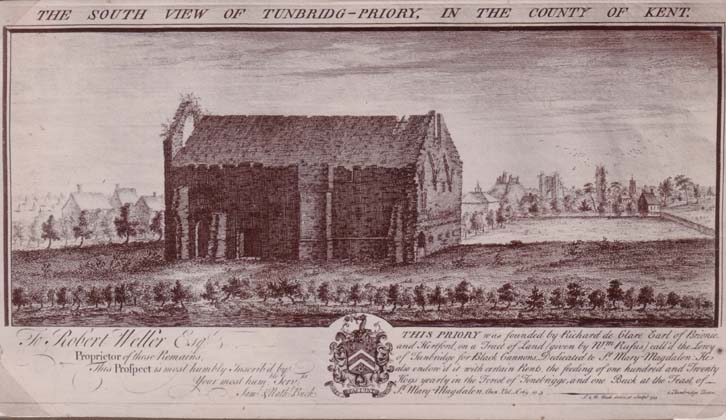 Tonbridge Priory
- was a priory
in Tonbridge,
Kent, England
that was established in 1124. It was destroyed by fire in 1337 and then
rebuilt. The priory was disestablished in 1523.
Tonbridge Priory
- was a priory
in Tonbridge,
Kent, England
that was established in 1124. It was destroyed by fire in 1337 and then
rebuilt. The priory was disestablished in 1523.
Tonbridge Priory was established in 1124 by Richard Fitz Gilbert de Clare, who held Tonbridge Castle.[1] He was buried in the priory following his death in 1136.[2] In 1139, a Papal bull was issued by Pope Celestine III. The priory was granted two cartloads of wood daily and the right of pannage for 120 pigs.[1] A buck was to be provided every year for the Feast of St Mary Magdalene.[3] In 1291, income for the priory amounted to almost £52 from properties located in East Anglia, Kent, Surrey and Sussex.[1] The priory enjoyed these rights until the forest of Tonbridge was forfeited to the Crown. King Richard II ordered that the priory should continue to enjoy the rights, although the right of pannage was reduced to 60 pigs.[2]
The priory was dedicated to St. Mary Magdalene. It was an Augustinian priory which had a range of buildings including a chapter house, church, dormitory, library, refectory and vestry.[4] In 1267, the priory was granted possession of the parish church in Tonbridge.[5] A Christmas feast during the reign of King Edward I consisted 2 quarters of beef, 3½ casks of beer, 200 loaves of bread, six cockerels, two hams, 100 herrings, two pigs and some wine,[1] at a cost of 16s 9½d.[6]
On 11 July 1337, the priory was destroyed by fire. It was rebuilt with assistance from the Bishop of Rochester and the Archbishop of Canterbury, who granted to the priory the right to take over the revenues of the church and vicarage at Leigh,[4] which was then worth £12 per annum
| - - - -
Richard Fitz Gilbert de Clare - (died 15 April 1136) was a Norman nobleman, the son of Gilbert Fitz Richard de Clare and Adeliza de Claremont. He founded the priory of St, Mary Magdalene, Tonbridge.
| - - - -
Gilbert de Clare, 1st Earl of Pembroke - Gilbert fitz Gilbert de Clare (c.1100 – 6 January 1148), son of Gilbert Fitz Richard and Alice de Claremont, was sometimes referred to as "Strongbow", although his son is better remembered by this name, was the first Earl of Pembroke from 1138.
| - - - - - -
Gilbert Fitz Richard - (died 1114/7) was son and eventual heir of Richard Fitz Gilbert of Clare and heiress Rohese Giffard. He succeeded to his father's possessions in England in 1091; his brother, Roger Fitz Richard, inherited his father's lands in Normandy. Gilbert's inheritance made him one of the wealthiest magnates in early twelfth-century England. He was the earl of Hertfordshire, but references rarely indicated the county; he was consistently called Earl Gilbert or Gilbert earl of Clare.
Gilbert may have been present at the suspicious death of William II in the New Forest in 1100. He was granted lands and the Lordship of Cardigan by Henry I, including Cardigan Castle. He founded the Cluniac priory at Stoke-by-Clare, Suffolk.
He married Adeliza/Alice de Claremont, daughter of Hugh, Count of Clermont, and Margaret de Roucy. She remarried one of the sons of Hervé de Montmorency after his death. Gilbert and Adeliza had at least eight children:
| - - - -
Richard fitz Gilbert - (bef. 1035 – c.1090), was a Norman lord who participated in the Norman conquest of England in 1066, and was styled "de Bienfaite", "de Clare", and "de Tonbridge" from his holdings.[1][2].
According to the medieval chronicler Gerald of Wales, the first of this great family, Richard de Clare, was the eldest son of Gilbert, surnamed Crispin, Count of Brionne, in Normandy. This Richard fitz-Gilbert came into England with William the Conqueror, and received from him great advancement in honour and possessions
He was rewarded with 176 lordships and large grants of land in England, including the right to build the castles of Clare and of Tonbridge. Richard fitz Gilbert received the lordship of Clare, in Suffolk, where parts of the wall of Clare Castle still stand.[5] He was thus Lord of Clare. Some contemporaneous and later sources called him Earl of Clare, though many modern sources view the title as a "styled title".
He served as Joint Chief Justiciar in William's absence, and played a major part in suppressing the revolt of 1075
| - - -
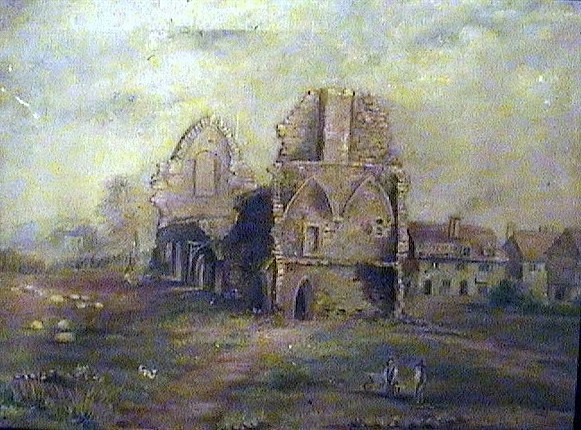 Tonbridge Collectables -
Tonbridge Priory - The tale is that the heart of Richard de Clare the owner of the castle in the reign of Henry lll 1216 -1272 was said to be buried in the priory.
Tonbridge Collectables -
Tonbridge Priory - The tale is that the heart of Richard de Clare the owner of the castle in the reign of Henry lll 1216 -1272 was said to be buried in the priory.
...
The ruins of the St Mary Magdalene stood on the land between Vale road and Priory road which
is now a car park. These ruins were demolished in 1842 to make way for the railway. A plea to the Railway Company was made to preserve the ruins but this was rejected
...
Finally we reached Somerhill House, a large beautiful Jacobean Mansion built around 1600’s now a school.
After walking around the house we came to the gardens and there it was the stone coffin was still there with a large cross carved on the lid. (No that's a typical Templar Sword cross!!! there are many examples of this typical Templar stone coffin)
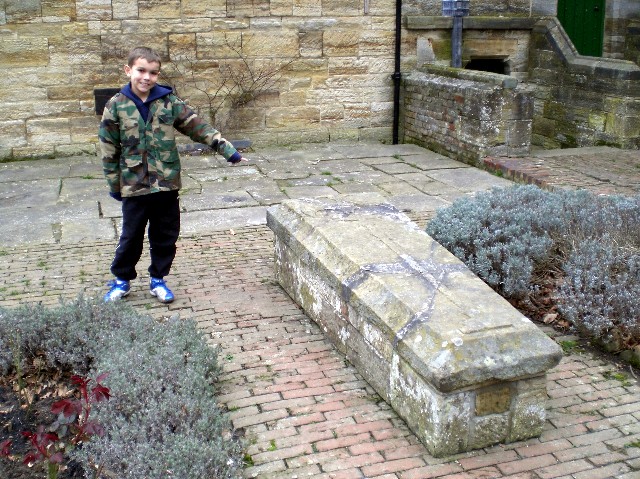
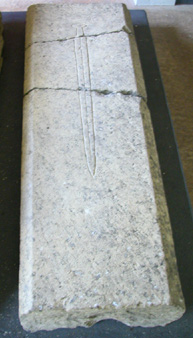 Roger de Mowbray's Tomb - 1188
Roger de Mowbray's Tomb - 1188
Concentrating on the Bristol - Somerset County history:
1186~1202 - Confirmation
by the Prior of St. James's, Bristol, to John, son of Ralph
Utlage, of land in Lewin's Mead
1200~1210 - Grant
by the Prior of St. James's, Bristol, to Margam Abbey, of land in Lewin's
Mead, Bristol, Formerly held by John, son of Ralph le Utlage
| - - - -
Berwick-upon-Tweed - is a town in the county of Northumberland and is the northernmost town in England, on the east coast at the mouth of the River Tweed. It is situated 2.5 miles (4 km) south of the Scottish border.
Burton upon Trent - is a town straddling the River Trent in the east of Staffordshire, England.
Full text of Calendar of the Patent Rolls Preserved in the Public Record Office Edward III
1310 - Nov 28
page - 290
1310 - Roger le Utlaghe - divers messuages in Burton-on-Trent - Nov 28 - Edward III
Pardon to the abbot and convent of Burton-on-Trent for acquiring in fee,
without licence in mortmain from the late king, divers messuages in
Burton-on-Trent from Roger le Utlaghe, Richard Cobard, and Emma
daughter of Hugh le Pestur, and also one acre of land in Calvermedwe
from William Cobard. By fine of 2 marks.
1310 - Roger le Utlaghe messuages in Burton-on-Trent - Nov 28 1310 - 4 Edward II - Burton upon Trent - Staffordshire, England - Letters patent of Edward [II] granting pardon to the Abbot and Convent of Burton for breach of the Statute of Mortmain in respect of various properties in Burton upon Trent - Property: messuage in Burton from Roger le Utlaghe, another from Richard Cobard, a third from Emma filius Hugonis le Pestur, all in Burton, and an acre of land in Calvermedwe from William Cobard.
1313 - Willielmus Outlagh - The Tallage of 6 Edward II - Bristollia Bristol - Tallage - Bristollia or, memoirs of the city ... - Gloucestershire - Bristol
1390 - ... in favour of Richard Bedewynde of Redynge 'hosteler'
and John Hosteler 'that was Richardes servant Bedewynde' of Redynge at suit of John
Outlawe of Bristol for ...
1392 - Simon
Outelawe, Michael Brailes plaintiffs - 1392 Sept. 29.-Oct. 5] York
- Premises: 9 messuages, 18 shops in Bristol and suburbs
1454 - Protection
to John Owtelawe in the retinue of John earl of Worcester - Oct 23
- 33 Henry VI - French Rolls - John
Tiptoft, Earl of Worcester - "the butcher of England" - in
1449 Lord
High Treasurer and then as Lord
Deputy of Ireland (1456–1457) - King
Henry VI's seizure with madness, in August 1453, supplied York with an
opportunity of getting control of the government without the use of force
against the King. ... the lords came up to London, early in 1454, with great
retinues
1533 - Adam Owtlawe, 'maryner' - St. Mary Matfelon - London Fines Henry VIII - Easter Anno 25 - St Mary Matfelon - church, popularly known as St Mary's, Whitechapel
1541 - Adam
Owtlawe - (£30) - '1541 London Subsidy roll: Tower Ward
1542 - Simon
Owghlawe owns land in Upton, afterwards possessed by Thomas Clere, 1542.
Thomas Clere
also had land here which formerly belonged to John Reynes of Acle. — Court of
Wards and Liveries, vi. 129.
1542 - Simon
Owghlawe - Outlawe -
land in Acle, Mowton, Boyton, Northbyrlyngham Fysshely and Upton
1543 - Adam
Owtlawe - send four ships to the Downes - Feb 23 - Sir Francis
Bryan to the Kings Council - Scotch prisoners - (Sir
Francis Bryan was a distinguished diplomat,
soldier, sailor,
cipherer, man
of letters, and poet.)
(Henry VIII)
1544 - July
1544 Expedition to Calais - Captain Adam Owtlawe
1544 - Ships
The Newe Barke 160 t., 120 m., Adam Owtlawe. (fn. 7) - Caleis
- Greate Shalop (D.), Oct 29 1544
1544 - Ships
- Great Shallop of Dover (Adam Owtlawe, c) - Cavendishe Shallopp
(Adam Owtlawe, c.) November 28 1544
1544 - Owtlawe,
Adam, [no place] 21 pynnyng - Prerogative Court of Canterbury - Probate
Wills page 397 - Adam Owtlawe's Will
1548 - Thomas Outlawe - King Edward VI. issued a proclamation, Oct. 1548 - accused of piracy - 300 crown reward
" They must know that p. and f. I W. prior of St. James of Bristol, and the brethren of that place authority and the retirement of our venerable father, Alan Theokesbirie [ Tewkesbury ] abbot and convent of that place granted and confirmed this Charter. John, son of Ralph Outlawe. Leowini the whole of that land in the meadow. Ralph his father had bought from the Ailwardo weaver (textore). "
Well lets look at that name Ailwardo ... that is AILWARD and/or AYLWARD : and I have found that Bristol/Ireland connection
"Ailward Juvenus, a merchant from Bristol, who was granted extensive lands in Ireland by Henry II, probably for his help with Henry's invasion of 1172" so this may have been the Ailwardo were looking for :
AYLWARD
- The AYLWARD name is derived from the old English name Aethelward, meaning "noble protector" (cf the modern
"adel vaardare" in Swedish (a wuffing connection?)). It is of patronymic origin - that is it is derived from a personal name.
The "original" Aethelward is, presumably, the one in the Encyclopaedia Britannica who was one of the noble family of
Wessex, and a near descendant (his nephew I believe) of King Alfred of burnt cakes fame.
It is not a very common name, except in certain parts of Ireland. The Aylward shield represents the Irish branch, who are all usually descended from
Ailward Juvenus, a merchant from Bristol, who was granted extensive lands in Ireland by Henry II, probably for his help with Henry's invasion of 1172. The lands include an area in the South-east called
Aylwardstown - very difficult to find (its now mostly a cattle farm). In County Kilkenny there is also another area that has a lot of
Aylwards, and there is even a castle - Shankill Castle in Paulstown, that was owned by the Aylwards until the male line died out in the late 1800s. It was then owned by the Toler-Aylwards, who finally sold it in the late 1980s. [For information on Shankill Castle see "A guide to Irish County homes" by Mark Bence-Jones (Constance)].
You come across the Aylward (or Ailward) name quite commonly in mediaeval times. As an example, below is
the story of St Godric who is of the Ailward family
... One merchant, became Saint Goderic. This holy man's father was named Ailward, (I am Aylward) and his mother Edwenna (I am Edward) became a
saint....They
were born in
| - - -
Godric of Finchale - (or Saint Goderic) (c. 1065 – May 21, 1170) was an English hermit, merchant and popular medieval saint, although he was never formally canonized. He was born in Walpole in Norfolk and died in Finchale in County Durham, England.
Saint Godric's life was recorded by a contemporary of his: a monk named Reginald of Durham. Several other hagiographies are also extant. According to these accounts, Godric, who began from humble beginnings as the son of Ailward and Edwenna, "both of slender rank and wealth, but abundant in righteousness and virtue", was a peddler, then a sailor and entrepreneur, and may have been the captain and owner of the ship that conveyed Baldwin I of Jerusalem to Jaffa in 1102. After years at sea, Godric reportedly went to the island of Lindisfarne and there encountered Saint Cuthbert; this will not have been a physical encounter as Cuthbert had long been dead and was by then interred at Durham Cathedral. This encounter changed his life, and he devoted himself to Christianity and service to God thereafter.
After many pilgrimages around the Mediterranean, Godric returned to England and lived with an elderly hermit named Aelric for two years. Upon Aelric's death, Godric made one last pilgrimage to Jerusalem, and then returned home where he convinced Ranulf Flambard, the Bishop of Durham, to grant him a place to live as a hermit at Finchale, by the River Wear....
| - - - The Aylward
name in Bristol : ]
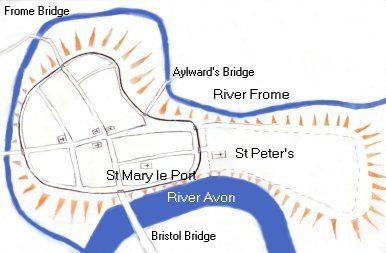 ...
...
From Æthelweard Mæw to Beorhtric
After the deaths of Æthelred (911) and Æthelflaed (918), Mercia lost even a semblance of independence from Wessex. Alfred's son Edward the Elder was King of England. The idea of separate kingdoms re-emerged in 955, when
Edwy succeeded to Wessex and his brother Edgar to Mercia, but after the death of Edwy in 959, Edgar ruled all
England.41 The Avon became the boundary between the shires of Gloucester and Somerset, rather than between kingdoms.
This helps to explain how a scion of the House of Wessex came to be lord of
Bristol. We have to piece together the story from confusing scraps of information. According to a local inquiry in 1318,
Bristol belonged before the Conquest to Aylward Mean and his son Bristric.
42 . Though the names and the relationship are mangled, these are real people. The founder's book of Tewksbury
Abbey, compiled in 1476 from earlier sources, provides another piece of the puzzle. It tells us that:
About the year 930, in the reign of King Athelstan, flourished a certain noble knight sprung of the illustrious stock of Edward the Elder and known by the name of
Haylward Meaw on account of his fair colouring. This man being strenuous in arms, powerful in honours and steadfast in faith, and not unmindful of his end, built for himself and Algiva his wife in the days of
King Ethelred and St. Dunstan the archbishop a small monastery on his lands at Cranborne and granted it possessions... He made Tewkesbury Priory, of which he was patron, wholly subject to it.
These things were done about the year 980. And Haylward, having died and received burial in the church which he had built, was succeeded by his son by Algiva, lord Algar, father of Britric, who according to the vow of his parents amplified the church which they had
begun.43
Again the tale is somewhat garbled, but we can translate Haylward Meaw into Æthelweard Mæw, the founder of Cranborne Abbey, Dorset, mother house of Tewkesbury Abbey, whose wife Ælfgifu and son Ælfgar made further grants to
Cranborne.44.
We shall see the connection between Bristol and Tewkesbury Abbey in the Norman period, but for the moment let us pursue this elusive family. The author of the founder's book would be on safe ground where he had monastic charters to work from, but the idea that Æthelweard Mæw flourished 50 years before his foundation of Cranborne Abbey is probably based on a misreading of 980 for 930, or perhaps a confusion with another Æthelweard; the date would make an implausibly long span for the three generations. Nor can we trust this late source on the reason for Æthelweard's nickname. Mæw meant "seagull". This seemed so unlikely to later writers that they transformed it into more comprehensible nicknames. The 19th-century edition of Dugdale's Monasticon edited the name as "Snew", possibly under the influence of Bristol historian Samuel Seyer, who explained that this was the local pronunciation of "snow", which made more sense to him as a name meaning fair.45
. Whatever the genesis of the name, it reveals nothing of Æthelweard's parentage. Yet the royal ancestry claimed for him seems plausible, since his grandson
Beorhtric (often written Britric) was a notable magnate in the time of Edward the Confessor, holding over 350 hides of land in Cornwall, Devon, Dorset, Gloucestershire, Wiltshire and
Worcestershire.46
The Viking menace returned in the reign of Æthelred, this time better organised and more powerful than before. By right of conquest
Sweyn of Denmark made himself king of England before his death in 1014. There followed a desperate attempt by the English to regain an English king. At this point Ælfgar, son of Meaw, turned traitor. He followed Eadric Streona, Ealdorman of Mercia, in joining the Danish army under Cnut against Edmund Ironside in
1016.47 We shall never know his reasons, but he certainly ended up on the winning side. Further turbulence followed the death of Cnut in 1035, but
it would seem that Ælfgar and his son Beorhtric weathered the storms with their patrimony intact until the Norman Conquest.
Since Bristol is given only a glancing mention in The Domesday Book, it is naturally not listed among the pre-Conquest manors of Beorhtric (or anyone else), but we can trace a connection.
Many of the lands of Beorhtric were given to Queen Matilda after the Conquest. The founder's book of Tewkesbury Abbey accounts for this by a romantic story taken from Norman chronicles, which may or may not have the slightest truth in it:
Matilda the wife of the Conqueror hated the said Brihtric Meaw because when sent abroad on an embassy for the affairs of the realm he refused her hand in
marriage. She afterwards married William, and having sought opportunity stirred up the king's wrath against the Saxon nobleman so that he was seized by the king's order in the manor of Hanley and conveyed to Winchester, where he died and was buried leaving no
heir.48 Hanley Castle, Worcestershire, formed part of the manor of
Tewkesbury:
After the queen's death the former estate of Beorhtric formed the Honour of
Gloucester,49. to which Bristol was certainly attached (see below). So it is
almost certain that Beorhtric held Bristol, which makes it quite credible that the town
was also held by his grandfather Æthelweard Mæw. This would be the walled burh.
If Bristol became a planned town in the reign of Alfred, then Æthelweard Mæw could have gained Bristol anything up to a century later. It is therefore plausible that he was responsible for another entrance to the town which appears to be a later addition to the plan and bears his name.
In Saxon planned towns, main streets lead to the main town gates and so they did in Bristol. By contrast
Aylward's Gate lay off the north-eastern intramural lane now Tower Lane. It gave access to Pithay, formerly known as
Aylward's Street, which led to Alyward's Bridge over the
Frome.50 . Aylward is certainly found as a Bristol surname in the 13th century, when Aylward's Bridge is recorded.
However a town gate and bridge are more likely to be constructed by a town authority, in this case its Saxon
lord.
The manor of Barton Regis was held by King Edward the Confessor; it presumably included St Peter's Church and the extra-mural settlement around it which has left traces in the archaeological record. The lands of Edward came into the hands of William I at the Conquest, which meant that the king had a convenient site for a Norman castle east of St Peter's, guarding the entrance to the town. Elsewhere the Normans did not hesitate to raze large areas within walled towns in order to create castles. However that was destructive of future revenues and there was no reason to do so here.
Bristol and the Honour of Gloucester
Queen Matilda died in in 1083, 51The Anglo-Saxon Chronicle so at the time of the Domesday survey in 1086 her former estates were in the hands of the Crown, which would explain why the chief revenues of Bristol were at that point being paid to the king along with his income from Barton Regis.52Domesday Book: Gloucestershire ed. J.S.Moore (1982), 1,21. William II used his mother's lands to form the Honour of Gloucester, which he granted to Robert Fitz-Hamon, as a reward for his loyalty.53G.E.C., The Complete Peerage, new edn. ed. V. Gibbs and H.A. Doubleday, vol. 5 (1926), p. 683. One of the most important manors of this great estate was
Tewkesbury. There Fitz-Hamon, under the influence of his wife Sibilla, rebuilt the monastery which had been a cell of Cranborne Abbey to such good effect that the monks of Cranborne were able to move to Tewkesbury in 1102, leaving Cranborne as a dependent cell. Fitz-Hamon also increased the endowment of what had become Tewkesbury Abbey.54 Victoria History of the County of Gloucester, vol. 2 (1907), p. 62. Among his gifts and those of his chaplain were St Peter's Church, Bristol, with all that pertained to it within and without the town and a tithe of the lordship revenues of Bristol.55 Calendar of Charter Rolls vol. 2, p. 490; Bristol Record Office 5139/238, published as The Earldom of Gloucester Charters ed. R.B. Patterson (Oxford 1972), p. 161, no.179. Here is evidence that Fitz-Hamon held both the town and castle of Bristol.
Fitz-Hamon's heir was his daughter Mabel, who brought the Honour of Gloucester to her husband Robert, illegitimate son of Henry I.
In 1121 Robert was created Earl of Gloucester. The revenues of Bristol were the largest item in the earl's
income.56. Robert continued his father-in-law's patronage of Tewkesbury Abbey. About 1137 he founded the Priory of St. James at Bristol as a dependent cell of Tewkesbury. It would be easier for the priory than its more distant mother house to administer the property within Barton Regis which had once belonged to St Peter's Church. So it is not surprising that we find among the possessions of the priory at the Dissolution the rectories of Stapleton, Mangotsfield and SS Philip and Jacob, Bristol. The priory was subsequently sold together with its possessions including land in Stapleton, Mangotsfield and elsewhere in the Hundred of
Barton.57
Robert of Gloucester and his son William, 2nd Earl of Gloucester fought long and loyally for Empress Matilda during the civil wars that followed Henry I's death. Bristol became the foremost stronghold of resistance to King Stephen. Ironically their ultimate success led to the royal seisure of Bristol Castle. When Matilda's son came to the throne as Henry II, his policy was to protect his hard-won authority by destroying or controlling castles throughout his realm. Although Earl William managed to expel the royal garrison of Bristol Castle in 1174, he surrendered the castle in 1175 and it remained in royal custody thereafter, supported by the profits of Earl's
Barton.58
Conclusion
It would seem that the defended town of Bristol was an important part of an estate dating back to the 10th century, held until the Norman conquest by a minor branch of
the house of Wessex. Æthelweard Mæw probably gained Bristol by grant from one of his royal relatives, many years after the town was laid out.
The walled town probably formed part of the ring of defences around Wessex and Mercia created by Alfred the Great and his
children. However the extra-mural position of St Peter's Church suggests that there was an earlier settlement, perhaps dating from the late 8th century, fitting the pattern of Mercian proto-towns elsewhere.
What I find interesting is that the Ailward's like the Utlage's were pre-conquest Saxons (Anglo-Danish ?) and this Bristol merchant was elevated with grants. Also originally from Norfolk. Also possibly connected to St. Godric, who originally was a merchant from Kings Lynn , was a mariner in the Mediterranean , and assisted in the First Crusade . Perhaps the Utlage's did similar things.
1172 - Torsten utlag - Reginaldus utlag - Dublin Roll of Names
Ireland under the Normans - Goddard Henry Orpen - Volume 2
Ailward juvenis, 'the king's merchant,' page 274 volume I (see below)
| - - - - -
Ayl-ward = noble guardian in Old Saxon
Here is part of the history of the Aylward family that I got from an
article published around 1980 in a newspaper from Waterford.
AYLWARD
Saxon: AEDHELWEARD (NOBLE PROTECTOR)
IRISH Aiglehrt
The original home of the family, was
to the east of Waterford, in the parish of Faithlegg, where the first of the
Aylwards was granted a considerable estate by King Henry II. His descendants
held Faithlegg for nearly five hundred years, until like so many other great
Irish families, they were sent by Crowwell “to hell or Connaught”.
As the Aylwards came over to
Ireland with Henry II, it is usually assumed that they were a Norman family.
Actually, they were Saxon in origin, and they had been in England for
centuries before the Normans arrived there. The name “Aylward” comes from
the Saxon “Aedhelweard” and means “Noble Protector”. It was quite a
common Christian name in Saxon England. As a surname, it is still
occasionally met with over there.
The Irish Aylwards are descended from a Bristol merchant and ship-owner named Aylward Juvenis (Aylward the counger), who may well have provided King Henry II with some of the ships that took him to Ireland in 1171. In addition to his Irish descendants, he left sons who succeeded to his business in Bristol. The Bristol Aylwards took a leading part in the life of their city and they must have been important people, for Bristol was at that time, second only to London in importance. One of them, Roger Aylward was one of the merchants whose job it was to import wines for use at the King’s table. His brother Richard was mayor of Bristol in 1239-40. There was an Aylward Street and an Aylward gate named after the family in Bristol. The Bristol Aylward died out with the death of John Aylward, merchand and ship-owner in 1427.
It was at the Great Council of
Oxford in 1177 that Henry II granted Faithlegg to Aylward Juvenis. He made
several grants of land in Ireland to his chief followers at this council,
including the grant of County Waterford to Robert le Poer, ancestor of the
Powers, who was the king’s marshal. Aylward must have been an important
man to be included in such exalted company.
John's first expedition to Ireland
The 1185 expedition of the future King John of England to Ireland has attracted much historical debate due to the lack of government records available and the subsequent reliance on sources such as the Irish Annals and the writings of Gerald of Wales.
The subject of John going to Ireland first came into question under the reign of his father, Henry II specifically with the Council of Oxford in the year 1177. This council agreed to have John made King of Ireland. This would appear to have been a strategy of his father's to divide his Angevin possessions between his four sons. The approval of Pope Alexander III was sought to have John crowned King of Ireland. Disagreements with first Alexander III and then his successor Pope Lucius III caused this to be delayed and instead John went as only Lord of Ireland.
In 1184 arrangements were made for John's departure with the sending of John Cumin and Philip of Worcester to prepare the ground for John's arrival. John arrived in Ireland in April 1185, landing at Waterford with around 300 Knights and numerous foot soldiers and archers.
Oxford, Council of - Oxford, Council of (May 1177). Following the death in 1176 of Richard fitz Gilbert, alias Strongbow, lord of Leinster, administration of his lands became the responsibility of the English crown during the minority of his heirs. At the Council of Oxford Leinster was divided into three areas centred on Dublin, Waterford, and Wexford, to which royal administrators were assigned. Henry II also designated his son John ‘lord of Ireland’ and made speculative grants of the kingdom of Cork (Desmond) to Robert fitz Stephen and Miles de Cogan, and of Limerick (Thomond) to Philip de Braose.
Internet Archive Search IRELAND UNDER THE NORMANS
Ireland under the Normans _Volume I
268 HENRY II IN IRELAND
The first We have one authentic memorial of Henry's Charter, stay in Dublin, namely,
the first Dublin charter, the original of which, executed in Dublin in the winter of 1171-2, is still preserved in the
municipal archives. By this charter Henry granted to his men of Bristol (Bristowa) his city of Dublin
(Duvelina), to be inhabited, together with all the liberties and free customs which they had at
Bristol and throughout his entire land. 1 By a subsequent charter, executed probably in 1174
at St. Lo, in Normandy, Henry granted to ' his burgesses of Dublin ' (i. e. whether men of Bristol
or not) freedom from various tolls and duties throughout his lands. In 1185 John confirmed
to his men of Bristol his father's grant, and in 1192 gave to the citizens of Dublin an extended
charter similar to that granted by him to Bristol in 1188.
HENRY II IN IRELAND 269
It was clearly necessary to replenish the city, and Henry's selection of Bristol, the
third city in England, as the source for the new colony, probably contributed to the commercial
success of Anglo-Norman Dublin. The merchants of Bristol were no strangers to Dublin,
and from no town in England could Dublin be so easily reached. Bristol had aided Henry's
expedition, and it was from the port of Bristol that supplies were sent to his
army.
274 HENRY II IN IRELAND
It appears also from a late enrollment 1 that in this year Henry granted the lands of Faithleg, near his landing-place at Crook in Waterford, to Ailward juvenis, as king's merchant, but we have no clear evidence of other grants out of the Crown lands at this time.
1 Chief Rememb. Roll, Dublin, 38 Eliz. (cited Lynch's Legal Institutions, p. 107). Ailward juvenis was probably son of Ailward the chamberlain, at this time in the young king's suite. Close to Faithleg Church is a Norman mote, and in what was the attached bailey stand the ruins of a later stone castle which belonged to the Ailwards up to 1690.
The English and the Normans Ethnic Hostility, Assimilation, and Identity. - Hugh M. Thomas
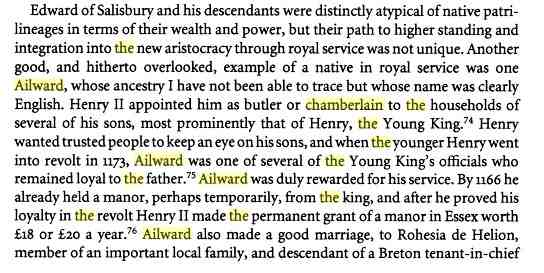
Ireland under the
Normans _VolumeII
Ireland under the Normans _ Volume III
Ireland under the Normans (Volume 4)
Dublin Charter From Henry II.—This is the oldest original Anglo-Norman document connected with Ireland now extant. By it Henry granted to his men of Bristol the city of Dublin, to be held from him with free customs and liberties similar to those of Bristol. The execution of this charter may be assigned to the period between November A.D. 1171, and the ensuing March, during which time Henry sojourned at Dublin. This highly important document is now preserved among the muniments of the city of Dublin. It is of small size, being only six-and-a-half inches in length, by five in breadth. A considerable fragment of the original seal, much discolored by age, is still attached to it.
Dublin Roll Of Names, Circa A.D. 1172.—This document, which I have styled
"Dublin Roll of Names," now consists of six parchment membranes, of about twenty inches in length by nine in width, written on both sides. The first of these surviving membranes contains
Dublin neither title nor heading, and bears traces of having been long carelessly treated. Portions of its front are discolored and obliterated, while its back has acquired a dark brown hue, and has been in some places rendered rough and illegible by friction.
This Roll formed the wrapper of a bundle of parchments which I found, in 1866, among the then un-arranged muniments of the Municipal Corporation of Dublin. The bundle contained several other membranes, which, from the style of the writing and the nature of the entries, appeared to be in sequence to the six membranes in which they were wrapped.
No entries specificatory of their age, class, or locality, are to bo found in
the six membranes ; but, from palseographic and other characteristics, I
assigned them to the latter part of the twelfth century. In this opinion I was
supported by the high authority of Sir T. Duffus Hardy, late Deputy Keeper of
the Public Records in England, who carefully examined the document with me. The
usual obscurity of members of ancient guilds, or civic communities, constituted
an impediment towards the establishment of the precise age of this Roll by
entries extant elsewhere in connexion with the individuals registered on it; and
few records of so early a period relating to Ireland now survive. However, through
independent external materials, chiefly in England, I succeeded in synchronizing
persons whose names are entered on the present
fifth and sixth membranes of this document with the early stages of Anglo-Norman
settlement in Ireland, in connexion with which it thus appears to be the
most ancient Roll extant. This result is supported by a partly torn heading of
the twelfth membrane, indicating the latter to be a Dublin Guild-Merchant Roll;
while on its fractured corner a name has fortunately survived which enabled me
to bring its date to the close of the twelfth century. A further confirmation of
this view is derived from the shattered heading of the fourteenth membrane; and
the succeeding membrane contains a full heading of the tenth regal year of Henry
III., A.D. 1226.
1172 - Torsten utlag - Reginaldus utlag - Dublin Roll of Names
Dublin Roll of Names [ 1172] Page 3
Page 6
Torsten utlag
Page 21
Reginaldus utlag
page 34
Radulfus de Britollo (Ralph Utlage of Bristol ?)
page 86 Dublin Guild Merchants 1226
Johannes Ailward de Bristoll
I am starting a section concentrating on the Irish invasion connections to Pembroke(shire) . Also Strongbow first went about the region collecting men of fortune to go on the expedition to Ireland....
Reference: English Society in the Eleventh Century Essays in English Mediaeval History
| - - - - -
Ireland
under the Normans _Volume I
...
THE FIRST CONQUERORS 1167-9
It was in August 1167 that Dermot returned to Ireland from his exile.
Though he did not wait for Strongbow or Fitz Stephen, he did not come quite
alone. He was accompanied by a knight of Pembrokeshire named Richard Fitz
Godebert (who appears to have been a Fleming from Roch Castle, near Haverford),
and a small body of troops.
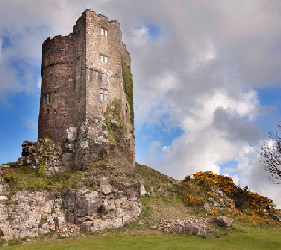 Roch
Castle is a 13th century castle,
located near Haverfordwest,
Wales.
Roch
Castle is a 13th century castle,
located near Haverfordwest,
Wales.
Built by Norman knight Adam de Rupe in the second half of the 12th century,[1] probably on the site of an earlier wooden structure. Roche is the usual French word for ‘Rock’, while rupestre signifies ‘a plant growing among rocks’.[2]
Built at the same time as Pill Priory near Milford Haven, Roch Castle was probably built in this location as one of the outer defences of "Little England" or "Landsker", as it is located near the unmarked border for which centuries has separated the English and Welsh areas of Pembrokeshire
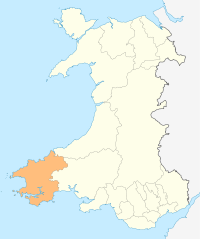 Pembrokeshire
- is a county in the south
west of Wales.
It borders Carmarthenshire
to the east and Ceredigion
to the north east. The county town is Haverfordwest
where Pembrokeshire County Council is headquartered.
Pembrokeshire
- is a county in the south
west of Wales.
It borders Carmarthenshire
to the east and Ceredigion
to the north east. The county town is Haverfordwest
where Pembrokeshire County Council is headquartered.
Much of Pembrokeshire, especially the south, has been English in language
and culture for many centuries. The boundary between the English and Welsh
speakers is known as the Landsker
Line. South Pembrokeshire is known as Little
England Beyond Wales.
...
Hwyel merged Dyfed with his own maternal inheritance of Seisyllwg, forming the new realm of Deheubarth.[4] The region suffered from devastating and relentless Viking raids during the Viking Age, with the Vikings establishing settlements and trading posts at Haverfordwest, Fishguard and Caldey Island.[4]
Dyfed, the region of Pembrokeshire, remained an integral province of Deheubarth but this was contested by invading Normans and Flemings who arrived between 1067 and 1111.[4] The region became known as Pembroke, after the Norman castle built in the Penfro cantref. But Norman/Flemish presence was precarious given the hostility of the native Welsh Princes. In 1136 Prince Owain Gwynedd to avenge the execution of his sister the Princess Gwenllian of Deheubarth and her children, with Gwenllian's husband the Prince Rhys swept down from Gwynedd with a formidable army and at Crug Mawr near Cardigan. There they met and destroyed the 3000 strong Norman/Flemish army. The remnants of the Normans fled across the bridge at Cardigan which collapsed and the Teifi river was choked with drowned Men at Arms and horses.
The Norman Marcher Lord Gilbert de Clare was also killed. Owains brother Cadwallader took de Clares daughter Alice as his wife. Owain incorporated Deheubarth into Gwynedd re-establishing control of the region. Mortally weakened Norman/Flemish influence never fully recovered in West Wales. Princess Gwenllian of Deheubarth is one of the best remembered victims.[5] In 1138 the county of Pembrokeshire was named as a county palatine
The county has long been divided between an English-speaking south (known as "Little England beyond Wales") and a historically more Welsh-speaking north, along an imaginary line called the Landsker.
The Lord Rhys, Prince of Deheubarth, Princess Gwenllian's son, reestablished Welsh control over much of the region and threatened to retake all of Pembrokeshire, but died in 1197.[4] After Deheubarth was split by a dynastic feud, Llywelyn the Great almost managed to retake the region of Pembroke between 1216 and his death in 1240.
Little
England beyond Wales - The area was formerly part of the kingdom of Deheubarth,
but it is unclear when it became distinguished from other parts of Wales. B. G.
Charles gives a survey of the evidence for early non-Welsh settlements in the
area.[3]
The Norse
raided in the 9th and 10th centuries, and some may have settled, as they did
in Gwynedd
further north. There are scattered Scandinavian placenames in the area,
mostly in the Hundred
of Roose, north and west of the River
Cleddau.
...
The first explicit documentary evidence is that of Gerald
of Wales and Brut y Tywysogyon, which record that "Flemings"
were settled in south Pembrokeshire soon after the arrival
of the Normans in the early 12th century. Gerald says this took place
specifically in Roose.
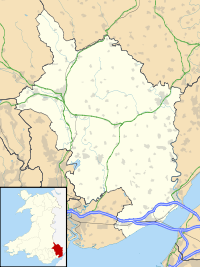
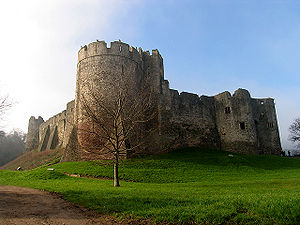 Chepstow
Castle - located in Chepstow,
Monmouthshire
in Wales, on top of cliffs overlooking the River
Wye, is the oldest surviving post-Roman stone fortification in Britain.[1]
Its construction was begun under the instruction of the Norman
Lord William
fitzOsbern,[2]
soon made Earl
of Hereford, from 1067, and it was the southernmost of a chain of castles
built along the English-Welsh
border in the Welsh
Marches.
Chepstow
Castle - located in Chepstow,
Monmouthshire
in Wales, on top of cliffs overlooking the River
Wye, is the oldest surviving post-Roman stone fortification in Britain.[1]
Its construction was begun under the instruction of the Norman
Lord William
fitzOsbern,[2]
soon made Earl
of Hereford, from 1067, and it was the southernmost of a chain of castles
built along the English-Welsh
border in the Welsh
Marches.
Richard de Clare, 2nd Earl of Pembroke (1st Creation) - Born 1130 Tonbridge, Kent, England
( Richard Fitz Gilbert de Clare founded the Priory of St Mary Magdalene in 1124 in Tonbridge and was an ancestor of Richard Fitz Gilbert a half brother of William the Conqueror)
Lord of Leinster, Justiciar of Ireland (1130 – 20 April 1176). Like his father, he was also commonly known as Strongbow (French: Arc-Fort). He was a Cambro-Norman lord notable for his leading role in the Norman invasion of Ireland.
Richard was the son of Gilbert de Clare, 1st Earl of Pembroke and Isabel de Beaumont. Richard's father died when he was about eighteen years old and Richard inherited the title Earl of Pembroke. It is probable that this title was not recognized at Henry II's coronation
As the son of the first Earl, he succeeded to his father's estates in 1148, but was deprived of the title by King Henry II of England in 1154 for siding with King Stephen of England against Henry’s mother, the Empress Matilda.[2]
Richard was in fact, described by his contemporaries as the Earl of Striguil,
Striguil being where he had a fortress at a place now called Chepstow, in Monmouthshire on the Wye.[3] He saw an opportunity to reverse his bad fortune in 1168 when he met Dermot MacMurrough (Irish: Diarmait Mac Murchadha), King of Leinster.
| - - - - -
Striguil - or Strigoil is the name which was used from the 11th century until the late 14th century, for the port and Norman castle of Chepstow, on the Welsh side of the River Wye which forms the boundary with England. The name was also applied to the Marcher lordship which controlled the area in the period between the Norman conquest and the formation of Monmouthshire under the Laws in Wales Acts 1535–1542
The Marcher lordship of Striguil was established by William fitz Osbern, who started the building of the castle at Chepstow. On his death in 1071 the lordship passed to his son, Roger de Breteuil, but he plotted against King William, was captured and imprisoned, and had his estates forfeited. The lordship then reverted to the English crown until about 1115, when it was granted to Walter fitz Richard de Clare, the son of Richard fitz Gilbert. It remained with the de Clare family, including Richard de Clare known as "Strongbow", before passing to William Marshal on his marriage to Richard's daughter Isabel in 1189
| - - - -
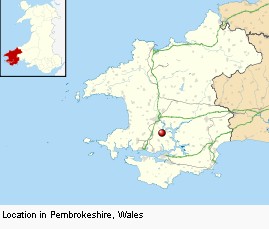
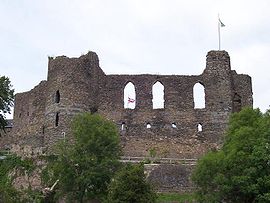 Haverfordwest
Castle - Haverfordwest was believed to have been a Danish settlement
prior to the Norman conquest of West Wales in 1093/94
Haverfordwest
Castle - Haverfordwest was believed to have been a Danish settlement
prior to the Norman conquest of West Wales in 1093/94
The vast majority of sources indicate that the structure was originally a Norman architecture stone keep and bailey fortress, founded by the Englishman Gilbert de Clare, earl of Pembroke in 1120.[3][4] While this date is generally consistent, although some indicate 1110 or 1113,[5] Pembrokeshire Records insist that the castle was actually originally built by Tancred the Fleming, so the original medieval town and castle would have been Flemish not Norman and they claim that the castle remained in the possession of the Tancred family until 1210.[2] The original castle is believed to have been first attacked (unsuccessfully) by Gruffydd ap Rhys Prince of Deheubarth in 1135 - 1136. In 1173 the castle had its first royal visit by Henry II of England who passed by the town on coming back from a trip to Ireland.
| - - - -
Ireland under the Normans - Page 256
HENRY II IN IRELAND 255
(Henry lands in Ireland Oct 17, 1171)
On October 16, all being ready and the wind at last favourable, the king embarked ' at the Cross ' below Pembroke, 2 and landed next day at Crook, near Waterford, the exact landing- place being probably the ferry-point now called Passage, about a mile from the old church of Crook, 1 and five miles from Waterford. His army consisted of five hundred knights and their esquires, and a large body of archers, about 4,000 in all. 2 A fleet of 400 ships was required to transport the men with their horses, arms, and provisions. 3 Among the knights who accompanied Henry were William FitzAudelin, the king's dapifer, Humphrey de Bohun, his constable, Hugh de Lacy, Robert Fitz Bernard, sheriff of Devon, and Bertram de Verdun. 4
4 This list is given in the Song of Dermot, 11. 2601-10. According to
the Gesta Hen. and Rog. Howden (ut supra) ,
William Fitz Audelin and Robert Fitz Bernard had been sent to Ireland some
time before and met Henry at Waterford. But we find both of these
individuals witnessing a charter at Pembroke on October 7, 1171 (Round's
Commune of London, p. 152), so that at most they can only have preceded the
king by a few days. To the above list we may add from the witnesses to
Henry's Dublin charter, William de Braose, Reginald de Curtenay, Hugh
de Gunderville, Randulph de Glanville, Hugh de
Cressy , and Reginald de Pavilly ; and from Henry's charter to Hugh de Lacy,
William de Albiny, William de Stoteville, Ralph de Verdun, William de
Gerpunville (the king's falconer), and Robert de Ruilly.
A topographical history of the county of Leicester - Rev. John Curtis
SHERIFFS, For the Counties of Leicester and Warwick, down to the 9th
of Elizabeth, (the two counties having been under one charge from the reign of
Henry II. until that period), and the list for this county continued to the
present time.
1171-80 Bertram de Verdun.
1181 Randolph de Glanville and Bertram de Verdun.
1182 Randolph de Glanville, Bertram de Verdun, Arnulph de Barton, and Adam
Aldelega.
1183 Randolph de Glanville, Adam de Audeley, Bertram de Verdun, and Arnnlph de
Barton.
1184 Arnulph de Barton.
1185 Randolph de Glanville and Bertram de Verdun.
1186 Randolph de Glanville and Michael Beler.
Reference: The Great Red Book of Bristol - Bristol (England) Vol 2 - Google Books
Page 305:
Burgage Tenure in Medieval Bristol
Fourteenth Century (1300's)
William Outlaghe for Richard de la Corder'
William Outlaghe for tenement formely of Richard de la Corderia
The Great White Book of Bristol - Bristol (England)
Another aspect of the Invasion of
Ireland from Bristol gives us a Berkeley connection.
Were the Utlage's working for Eadnoth or Harding? Had they been with Harold?
The "Berkeleys" are the only Anlo-Saxon Pre-conquest family that I know of to survive and thrive :
Eadnoth the Constable - (died 1068)[1] also known as Eadnoth the Staller, was an Anglo-Saxon landowner and steward to Edward the Confessor and Harold II, mentioned in Domesday Book as having 30 holdings in Devon, Dorset, Somerset and Wiltshire before the Norman conquest.[2] He may also have been the same person as Eadnoth of Ugford, also known as Alnoth.[3]
Eadnoth was killed at Bleadon in 1068, leading a force against the two sons of Harold II, who had invaded Somerset.
His son Harding became sheriff reeve of Bristol and one of his grandsons was Robert Fitzharding who became lord of Berkeley.
Harding of Bristol - (born circa 1048, died circa 1125) was sheriff reeve of Bristol, with responsibility for managing a manorial estate and perhaps similar duties to those of a magistrate.[1][2] He was the son of Eadnoth the Constable, an Anglo-Saxon thane who served as steward to Edward the Confessor and Harold II.[3] He was the father of Robert Fitzharding who became lord of Berkeley, Gloucestershire
Robert
Fitzharding - (c. 1095–1170) was an Anglo-Saxon
nobleman from Bristol
who was granted the feudal
barony of Berkeley
in Gloucestershire.
He rebuilt Berkeley
Castle, and founded the Berkeley
family which still occupies it today.[1]
He was a wealthy Bristol merchant and a financier of Henry Plantagenet, Duke of
Aquitaine, who was the rival of King
Stephen (1135–54) during the period known as The
Anarchy and who subsequently became King
Henry II (1154–89). Fitzharding founded St. Augustine's Abbey,
which after the Reformation
became Bristol
Cathedral.[2]
Many members of the Berkeley family were buried within it, and some of their
effigies survive there. As J.
Horace Round asserted he was one of the very few Anglo-Saxon noblemen who
managed to retain their noble status in Norman England and successfully
integrate with the Norman nobility, if not the only one
...
In 1140, Fitzharding founded St Augustine's Abbey as a Victorine
Augustinian
monastery.
The chosen site was in Billeswick, just across the River
Frome from Bristol Castle.
...
According to the 13th century Norman
verse The
Song of Dermot and the Earl, Fitzharding acted as an intermediary between
Dermot
MacMurrough, the exiled King
of Leinster, and Henry II in Dermot's attempts to raise Norman support
for his planned recapture of Leinster.
The song tells that Dermot was a guest in Fitzharding's house in Bristol
Bristol Cathedral - The Cathedral Church of the Holy and Undivided Trinity is the Church of England cathedral in the city of Bristol, England, and is commonly known as Bristol Cathedral. Founded in 1140, it became the seat of the bishop and cathedral of the new Diocese of Bristol in 1542
Bristol Cathedral was founded as St Augustine's Abbey in 1140 by Robert Fitzharding, a wealthy local landowner and royal official. As the name suggests, the monastic precinct housed Augustinian canons. The original abbey church, of which only fragments remain, was constructed between 1140 and 1148 in the Romanesque style, known in England as Norman. Further stone buildings were erected on the site between 1148 and 1164
Maurice de Berkeley - Sir Maurice de Berkeley "the Resolute" (1218 - 4 April 1281), 8th (feudal) Baron de Berkeley, was an English soldier and rebel, residing at Berkeley Castle in the English county of Gloucestershire.
Maurice was born in 1218 to Thomas de Berkeley and Joan de Somery. He married Isabel de Croun FitzRoy, the daughter of Richard FitzRoy, Baron of Chilham (an illegitimate son of King John of England) and Rose de Douvres, sometime before 12 July 1247.
Berkeley fought in the French Wars and was invested as a knight before 1242. He inherited the title of Baron de Berkeley in 1243 and, on 14 December 1243, he had livery of his father's lands. He fought in the war in North Wales and in 1264 he joined the Barons against King Henry III. Berkeley died on 4 April 1281 and was buried in St Augustine's Abbey in Bristol.
Peerage - Thomas de Berkeley -
Thomas The
Observer Or Temporiser De Berkeley (1170-1243) - born 1170 Of Berkeley,
Gloucestershire, England
died 29 Nov 1243 Berkeley Castle, Berkeley, Gloucestershire, England
buried St Augustine Aby, Bristol, Gloucestershire, England
father: Maurice
Fitz Harding "The Make Peace"
born 1120 Bristol, Gloucester, England
died after 16 Jan 1189/90 Bristol, Gloucester, England
| - - - -
Berkeley Castle - (historically sometimes spelt Berkley Castle) is a castle in the town of Berkeley, Gloucestershire, UK (grid reference ST685989). The castle's origins date back to the 11th century. The castle has remained within the Berkeley family since they reconstructed it in the 12th century, except for a period of royal ownership by the Tudors. It is traditionally believed to be the scene of the murder of King Edward II in 1327
The first castle at Berkeley was a motte-and-bailey, built around 1067 by William FitzOsbern shortly after the Conquest.[4] This was subsequently held by three generations of the first Berkeley family, all called Roger de Berkeley, and rebuilt by them in the first half of the 12th century.[5] The last Roger de Berkeley was dispossessed in 1152 for withholding his allegiance from the House of Plantagenet during the conflict of The Anarchy, and the Lordship of Berkeley was then granted to Robert Fitzharding, a wealthy burgess of Bristol and supporter of the Plantagenets. He was the founder of the Berkeley family which still holds the castle.[4][6][7][8]
In 1153–54, Fitzharding received a royal charter from King Henry II giving him permission to rebuild the castle,[8] with the aim of defending the Bristol - Gloucester Road, the Severn estuary, and the Welsh border.
Fitzharding built the circular shell keep during 1153–56, probably on the site of the former motte. The building of the curtain wall followed, probably during 1160–90 by Robert and then by his son Maurice.[4][8]
Much of the rest of the castle is 14th century and was built for Thomas de Berkeley, 3rd Baron Berkeley: Thorpe's Tower, to the north of the keep, the inner gatehouse to its southwest, and other buildings of the inner bailey
| - - - - -
Original Viking invader of Ireland:
Turgesius - died 845) (also called Turgeis, Tuirgeis, Turges, and Thorgest) was a Viking chief active in Ireland who is said to have conquered Dublin. It is not at all clear whether the names in the Irish annals represent the Old Norse Thurgestr or Thorgísl.[1][2] John O'Donovan and Charles Haliday independently identified him with Ragnar Loðbrók, but the identification is not generally accep
| - - - - - -
Ireland
under the Normans _Volume I
CHAPTER III - DERMOT SEEKS FOREIGN AID 1166-7
Dermot, once powerful King of Leinster, on the first day of August 1166, with some few followers, stole away, a fugitive from his native land. After a fair passage he landed at Bristol, even then an important port and commercial centre, and one well known to the Norse merchants of Dublin, Wexford, and Waterford. He and all his company were entertained by Robert Fitz Harding at his house near the monastery of St. Augustine, just outside Bristol.
He was an old man in 1166, having been born in 1085. He was reeve of
Bristol and had purchased land in the immediate neighbourhood of the town,
viz. the manor of Bedminster, including the vill of Redcliff on the other
side of
the river, and the vill of Billeswick to the southwest, where he had founded an
abbey for Augustinian canons. He had supported Earl Robert of Gloucester and
Matilda in the struggle with Stephen, and had won the favour of Matilda's son,
who rewarded him with the fief of Berkeley.
It was probably through the trading relations that had subsisted for some
time between the Ostmen of Dublin and the merchants of Bristol that Dermot had
become acquainted with the reeve of the latter town, and was able to count on
his hospitality and friendship. These trading relations afterwards supplied a
motive for Henry's effort to colonize the depleted city of Dublin with his men
of Bristol, and in this connexion it is worth noting that among the earliest
citizens of the Anglo-Norman town was ' John son of Jordan son of Harding V
possibly a nephew of Dermot's host.
...
80 DERMOT SEEKS FOREIGN AID
It certainly looks as if Dermot knew of Henry's meditated expedition
into Ireland, and had perhaps even heard of
Adrian's Bull. At any rate, it is very probable that Fitz Harding
knew all about Henry's designs. He was his intimate and trusted
friend. When Henry was nine years old, Geoffrey of Anjou had sent him
to Bristol to his uncle, Earl Robert of Gloucester, and he lived in
Bristol Castle for four years. Then was formed his friendship with Robert
Fitz Harding, which remained unbroken for life.
When Henry came to England again in 1152 he was assisted by Fitz Harding,
who was rewarded, as we have seen, with the fief of Berkeley, and no
doubt every time Henry went into Wales he saw Fitz Harding on the way.
Fitz Harding, Henry's trusted and favoured vassal, must have known of Henry's
ambitious views with regard to Ireland, and it was prob- ably on Fitz Harding's
advice that Dermot took the unprecedented course of appealing to the
Angevin king.
| - - - -
Much later in Virginia:
Sir William Berkeley (governor) - 1605 – 9 July 1677) was a colonial governor of Virginia, and one of the Lords Proprietors of the Colony of Carolina; he was appointed to these posts by King Charles I of England, of whom he was a favourite.
---- >>> Back to Outlawe Research Journal - Page 4